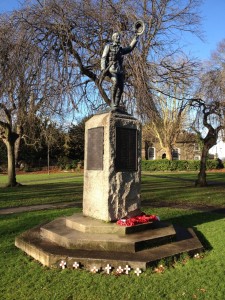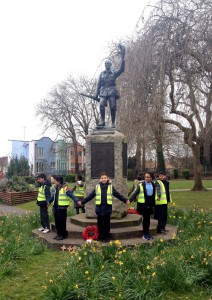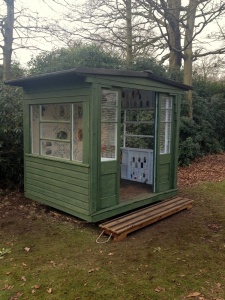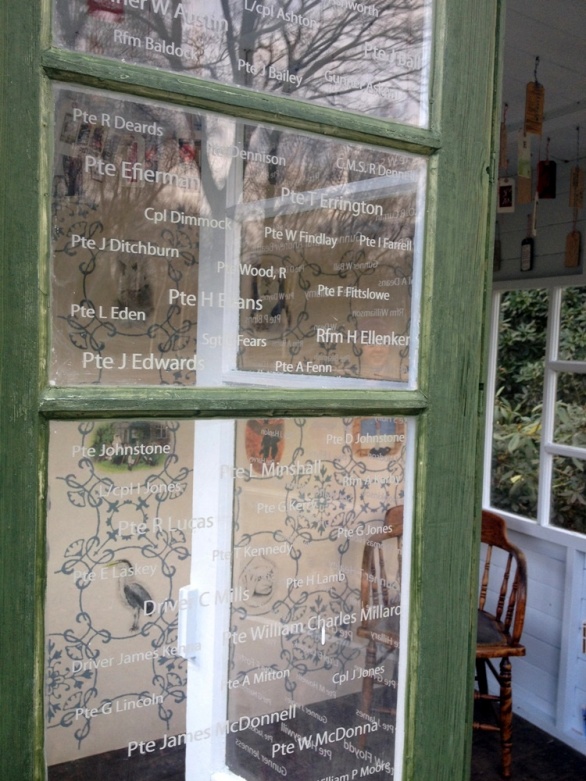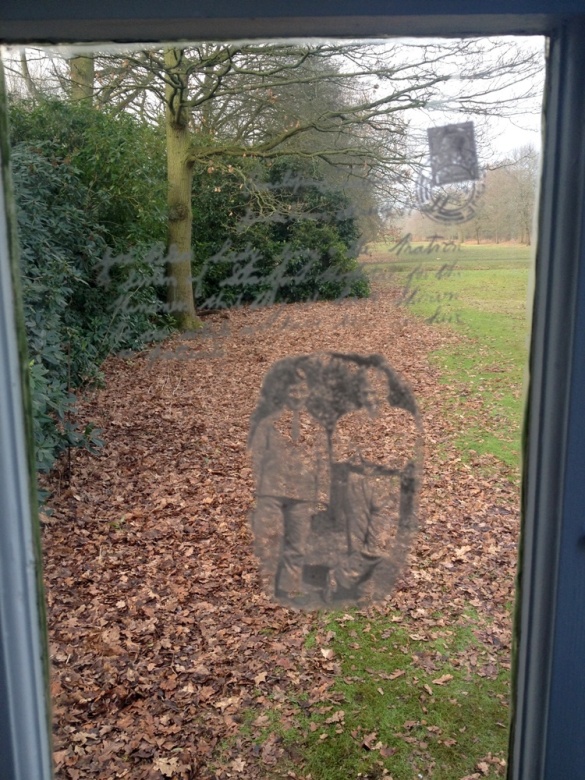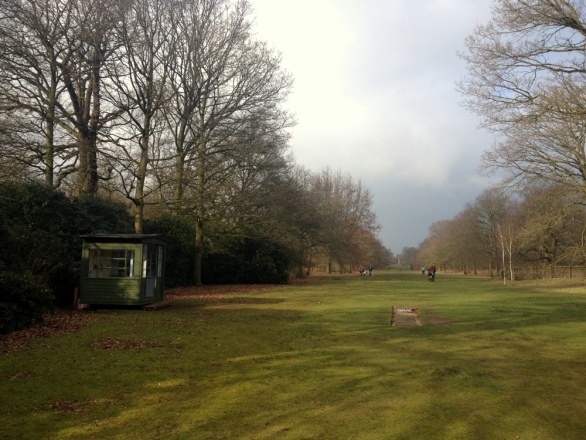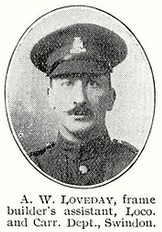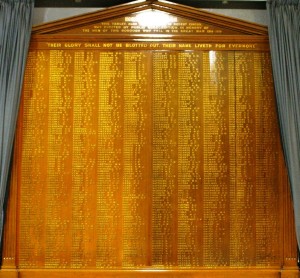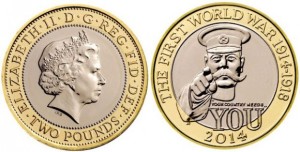Archive for the ‘Miscellany’ Category
A raid with severe repercussions: the mutilation of 8th Lincolns dead at Ghissignies, 2-3 November 1918
In the course of research for a client whose relative had served in the 13th Battalion Royal Fusiliers I was reading the unit war diary when the following passage, taken from 11 November 1918, the day the armistice came into effect, stopped me in my tracks:
11 November 1918
Bodies of dead killed on 24/10/18 were buried at GHISSIGNIES. It was found that the majority of the men had been deliberately shot in the head by the enemy. The men in question had been wounded: those that were able to walk were taken by the enemy and the remainder dealt with as stated above. Bodies of men of the Lincolnshire Regt. who had been killed about 30th Oct. were found to have been mutilated, hands hacked off at the wrists and eyes gorged [sic] out.
[13th Battalion Royal Fusiliers War Diary, UK National Archives, Ref: WO95/2538/3]
I have read plenty of British atrocities against German troops on the Somme in 1916 (there are files of such accounts in the archives at Freiburg). But on the British side I was only aware of Major Henry Hance’s (179 Tunnelling Company RE) description of Mash Valley on the Somme in mid-July 1916 in which he describes the British dead having been bayoneted ‘always thro’ the neck’ and the dead hanging on the wire having head their heads bashed in. But the 13th Royal Fusiliers war diary extract invited more research. Could this really have happened – British soldiers with hands hacked off and eyes gouged out by the enemy?
No additional information was available in the 13th Royal Fusiliers diary so moved on to the 8th Lincolnshire Regiment’s diary. The 13th Royal Fusiliers’ account had mentioned the battalion’s dead ‘who had been killed about 30th Oct.’ A brief look at the 8th Lincolns’ war diary confirmed any dead could not have been from that date (the battalion were in the line under heavy shellfire and had two Other Ranks wounded). Much more likely was the night of 2-3 November when ‘A’ Company raided German posts at the northern end of the village of Ghissignies, southwest of Le Quesnoy (of New Zealand Division fame).
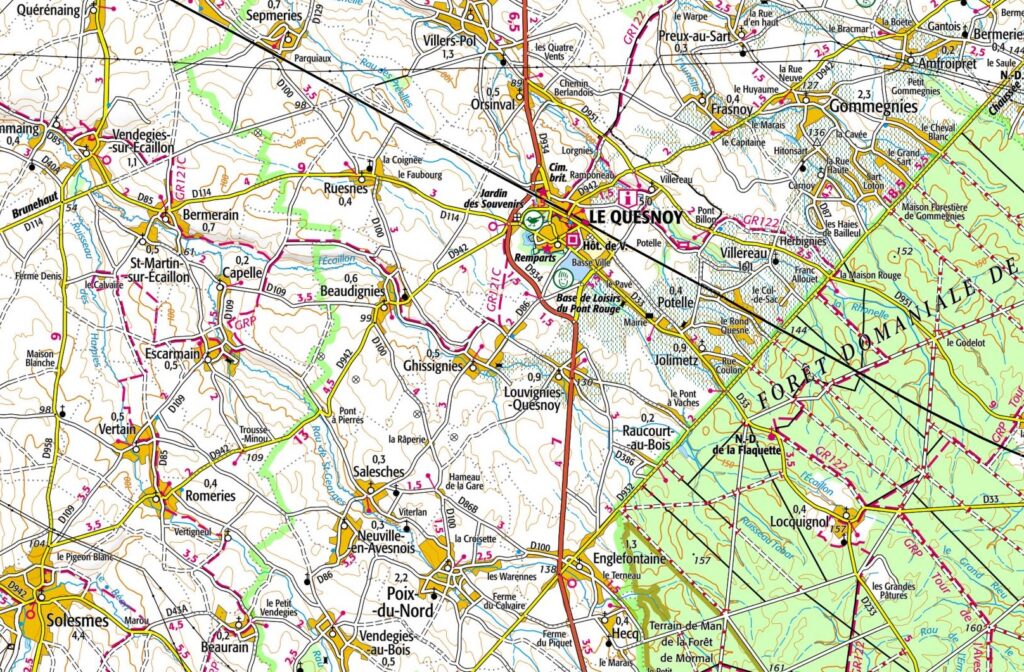
IGN map showing Ghissgnies in relation to Le Quesnoy
A Google Maps link to the village of Ghissignies can be found by clicking HERE.
The relatively sparse diary entries for 2-3 November are recorded below:
2/11/18 In the line – “A” Coy raided posts at level crossing in X5a at 23.45 hrs. Between 30 & 40 casualties inflicted on enemy. Heavy resistance offered. Casualties 11 O.R. killed, 18 O.R. wounded, 1 O.R. missing, 1 O.R. acc[identally] wounded.
3/11/18 In the line – Trench mortar activity on front line – casualties 12 O.R. killed, 17 O.R. wounded, 1 O.R. missing, 1 wounded acc. sprained wrist.
[8th Battalion Lincolnshire Regiment War Diary, UK National Archives, Ref: WO95/2529/1]

Annotated map extract from 37th Division HQ war diary showing Ghissignies and the chapel crossroads with area of raid marked
Clearly, the success of a single company raid which resulted in 31 casualties to the attacking force is questionable. The following day the Battalion cleared the position raided on 2 November with relatively little loss. Their casualties that day were the last sustained by the Battalion in the Great War.
4/11/18 “D” Company withdrew 2 platoons to SALECHES in X.19.b – 2 platoons followed left flank 111th Infantry Brigade mopping up the crossing & orchards in vicinity of chapel in X.5.a & b and R.35.. c & d. – 1 platoon establishing posts X.5.b.30.85 to R.35.d.15.15 –1 platoon X.b.20 – 70 to X.5.b.10.90. 24 prisoners captured in this operation – working from the south, 2 platoons of B. Coy mopped up Railway to Level Crossing in X.5.a.
In the evening the Bn moved to LOUVIGNY in area S.8.b & d.
[8th Battalion Lincolnshire Regiment War Diary, UK National Archives, Ref: WO95/2529/1]
As is so common when studying trench raids, the area in which this action took place is very small. British wartime maps (above) show the Le Quesnoy road leading to a crossroads at the north-eastern edge of the village. A chapel is marked on the crossroads but online research shows this to have been the existing calvary which was unveiled in 1852.
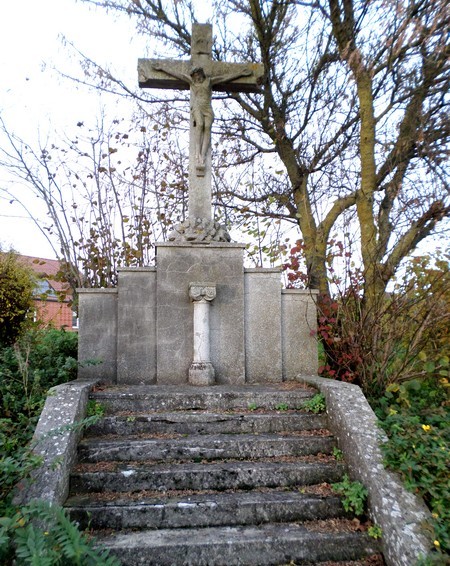
The Calvaire at the crossroads, Ghissignies. Image from: http://villesetvillagesdelavesnois.org/ghissignies/ghissignies.html
As part of 63rd Infantry Brigade, I hoped that the 8th Lincolns’ raid of 2-3 November would receive more attention in the Brigade war diary. And it was here that I struck gold with a detailed account provided in a Report on Operations, Oct 23rd – Nov, 4th, 1918, including gruesome descriptions of disfigurement and mutilation of British dead:
Nov 2nd.
At 2345 hours 8th Lincolnshire Regt. raided the enemy’s positions on the railway about the Chapel, X.5.a., under an artillery and trench mortar bombardment. This raid was carried out on a one platoon front with one platoon in close support. The railway was entered by the leading platoon and several casualties were inflicted on the enemy. 3 prisoners were taken but subsequently escaped. The supporting platoon was unable to reach the railway owing to heavy hostile machine-gun fire from the railway cutting. Our casualties were somewhat heavy, including 12 other ranks reported missing. In the subsequent advance on the 4th inst., the bodies of 11 were found buried by the enemy in the railway cutting. On being examined the bodies were found to have been terribly disfigured. One, the body of No. 241186 Corpl. G.A. DICKENSON, had six bayonet wounds, and one hand cut off. In addition both eyes were missing and had apparently been gouged out. It is not thought possible that these wounds could have been inflicted in the course of actual fighting.
[63rd Infantry Brigade War Diary, UK National Archives, Ref: WO95/2529]
A railway embankment bisected the Le Quesnoy road just before the crossroads. However, as noted in 63rd Brigade diary, British maps of the area were not wholly accurate:
The maps of this area had been found to be very misleading: what was taken to be a level crossing at X.5.a.5.5 was proved to be a very steep railway cutting fully 12 feet deep with a destroyed road bridge over the railway.
So, for the two assaulting platoons, what had appeared to be a standard raid had swiftly deteriorated into a tragic and bloody action. The war diary for 37th Division General Staff HQ reiterates the salient points of the raid:
Successful raid carried out by 63rd Brigade at 23.45 hours. Objective of raid level crossing X.5.a. Raiding party reached objective and inflicted severe casualties on the enemy. 3 prisoners were taken but owing to the escort being wounded on their way down with prisoners they escaped.
[37th Division Headquarters Branches and Services: General Staff War Diary, UK National Archives, Ref: WO95/2515]
However, it was 37th Division Intelligence Summary No 8., dated 7 November 1918 that provided most detail. It showed that the attacking force was met by sustained machine gun fire as soon as the advance began. One party working north along the railway made it into the 12ft deep railway cutting which was full of cubby holes, both at the bottom and higher up. Heavy fighting ensued and the report concluded thirty casualties were sustained by the Germans (almost certainly an overestimate – there are countless examples of British estimates of German casualties in raids bearing no relation to actual losses recorded in German reports. These numbers should always be treated with a healthy dose of scepticism – after all, those making the claim knew all too well there was no way their superiors could check inflated claims). Having suffered heavy casualties themselves and low on bombs and ammunition, the party withdrew. Other parties aiming to work south along the railway were stymied by sustained machine gun fire which caused heavy losses amongst the attacking Lincolns.
There is also mention of three German prisoners shooting their lone escort and escaping and a warning that prisoners should be properly searched for weapons upon capture to prevent such instances occurring.
7/11/18.
A raid was carried out on the night 2/3rd of November by two platoons of the right Bn in the vicinity of the level crossing in X.5.a. at 23.45 hours. The assembly was successful, but two machine guns, one on the railway crossing and the other about 30 yards north of the house X.5.a.40.35 opened fire immediately the party started to advance. One party, working north along the railway reached the hedge in spite of heavy fire, crossed it, and dropped into the railway cutting which was found to be full of cubby holes, both at the bottom and higher up.
The party started to mop up at once but was unable to reach the machine-gun at the level crossing. 30 casualties were inflicted on the enemy in spite of considerable opposition, particularly from the men in the upper cubby holes.
The party was finally forced to withdraw, their bombs and ammunition being exhausted and only one officer and 2 O.R. remaining unwounded.
Three prisoners was sent back under a lightly wounded escort. One of those prisoners drew a revolver and shot his escort. The escort of the other two was again wounded whilst withdrawing and they also escaped.
Other parties attempting to mop up posts in X.5.a.5.4 and to work south along the railway were unable to gain ground owing to heavy machine-gun fire in spite of repeated efforts to knock out the guns. The majority of our men were wounded in this attempt.
The raid was successful in that it showed that the enemy was still holding this section of the front in strength.
NOTE. The loss of the three prisoners emphasises the fact that prisoners should be thoroughly searched for weapons directly they are captured.
[37th Division Headquarters Branches and Services: General Staff War Diary, UK National Archives, Ref: WO95/2515]
Based upon these accounts it seems most likely the soldiers recorded in 63rd Brigade war diary whose ‘bodies were found to have been terribly disfigured’ probably came from the party which entered the railway embankment and fought so bitterly with the enemy ensconced in their cubby holes. Sadly, I doubt it will be possible to find further information on the events of that night – whether or not the wounds to British soldiers were deliberate but experience leads me to believe they were. The troops had seen their fair share of fighting and killing and knew the difference between wounds sustained in the course of action and deliberate mutilation. That these accounts are taken from official British sources (war diaries from Battalion, Brigade and Division) as opposed to a post-war memoir also adds credence to their veracity. Furthermore, by this stage of the war there was no need for inflated accounts of German atrocities to be used for propaganda.
It is certainly possible that assaulting Lincolns who entered into a bloody fight in the railway embankment, killing a number of German defenders were offered no mercy. Maybe German survivors were not in the mood to take prisoners and wanted revenge? To assume such incidents did not happen over four years of a bitter war is naïve and misses the essential point of warfare – namely, to kill the enemy.
As for the 8th Lincolns dead, there are sixteen soldiers from the Battalion now buried in a long line in the nearby Ghissignies British Cemetery. Based upon the sources above, eleven of these were disinterred from their shallow burial in the railway embankment – these are the men whose bodies were disfigured – with the remaining five ‘conventional’ casualties from the action (most likely from machine gun fire as they attempted to work south along the railway).
Below is a list of these dead taken from the CWGC website.
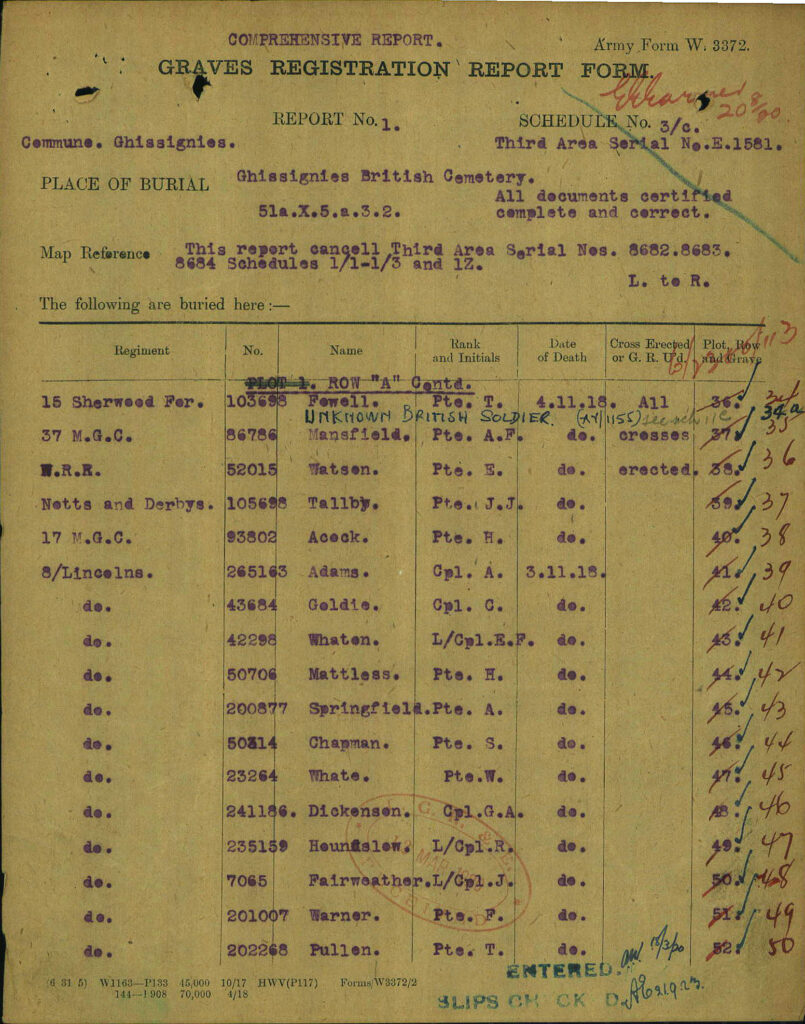
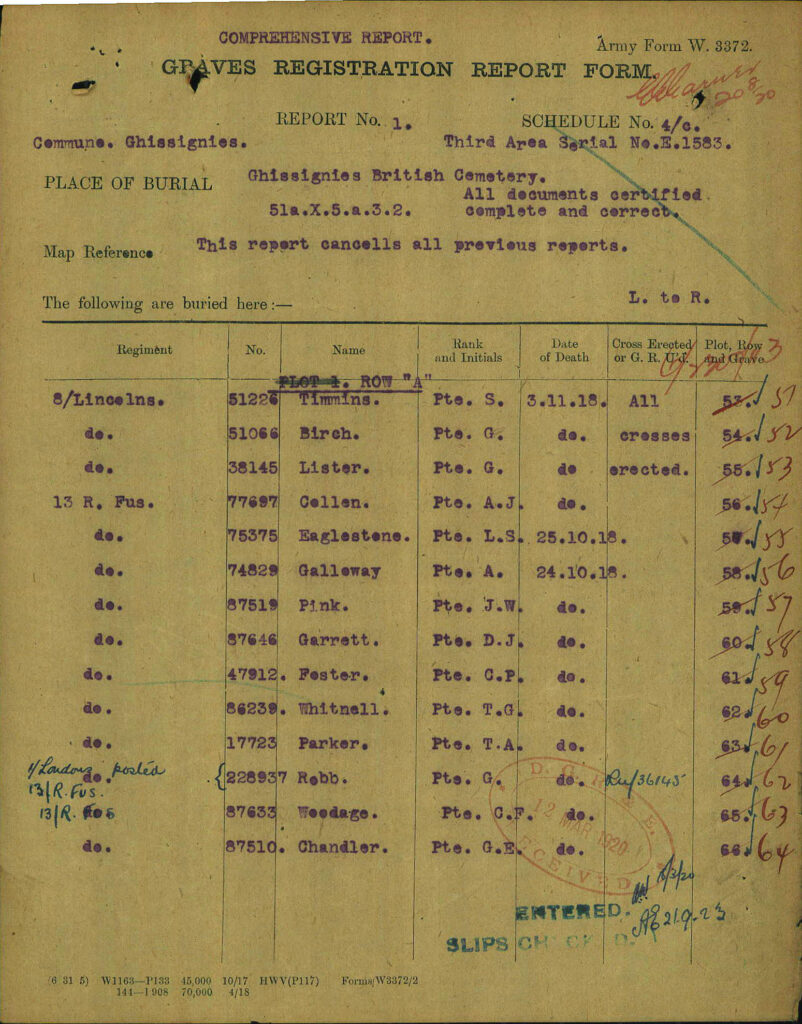
It includes 241186 Corporal George Dickenson whose body had six bayonet wounds, one hand cut off and both eyes missing (apparently gouged out). Two graves along lies 7065 Lance Corporal John Fairweather MM, a recipient of the 1914 Star who went overseas with the 1st Battalion in September 1914, served with a number of different battalions and earned the Military Medal in 1917. I would welcome any further detail on these men. Many of the dead from this raid are listed in the Weekly Casualty List (War Office & Air Ministry ) for 28 January 1919.
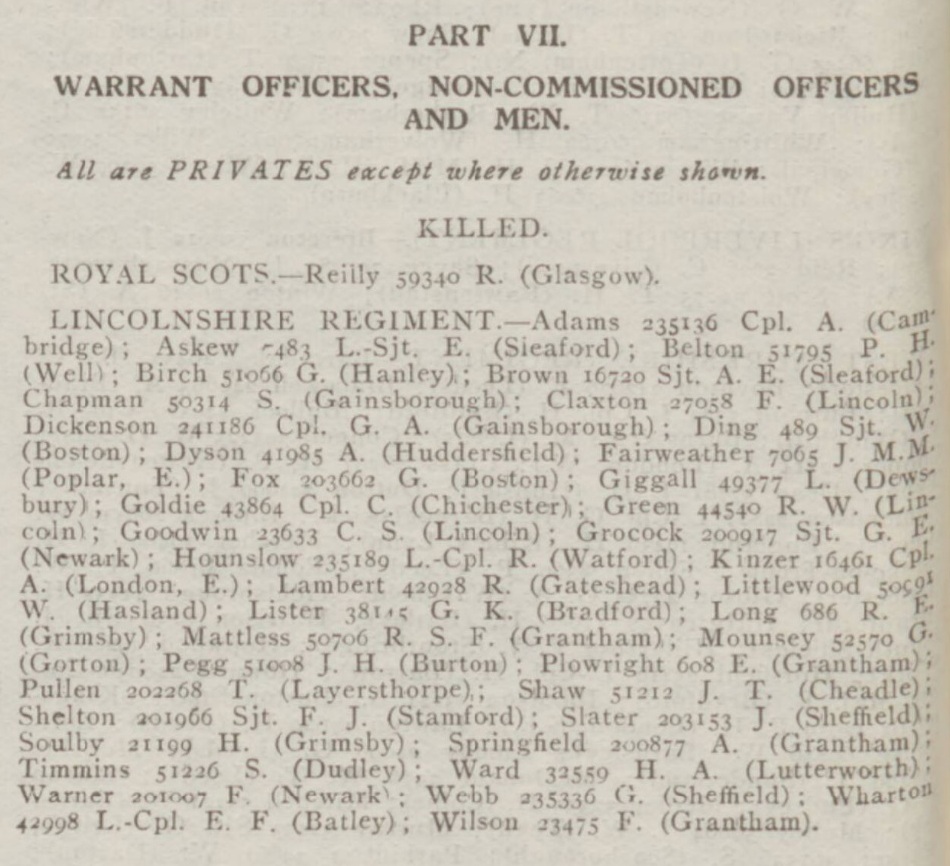
Weekly Casualty List (War Office & Air Ministry ) – Tuesday 28 January 1919
So, a strange and disturbing case of battlefield mutilation right at the end of the war. The village is once more a quiet spot and a roundabout now sits at the road junction. A water tower has been built between the Route de le Quesnoy and Route de Louvigny. Other than the military cemetery 100 metres down the road towards the village centre there is nothing to indicate any fighting took place here. When we get out of lockdown and visits to France and Flanders recommence I will stop at Ghissignies, far from the well-trodden spots of the Ypres Salient or the 1916 Somme battlefield and pay my respects to those men killed just a few days before the guns fell silent.

Modern aerial view of raid site at Ghissignies. Taken from Geoportail
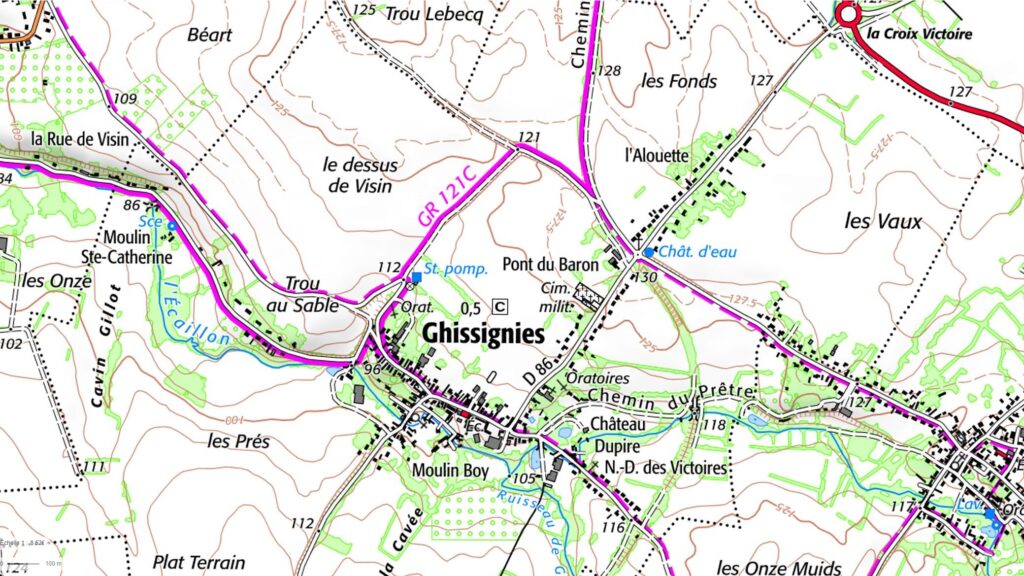
IGN map of the village of Ghissignies
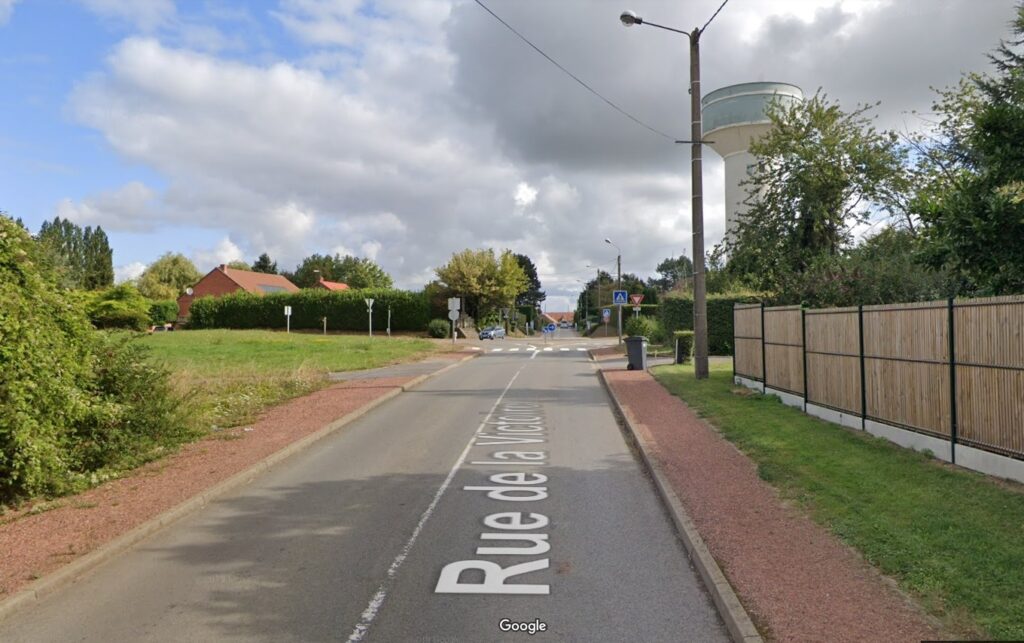
Image from Google Street View looking up to site of railway embankment and raid
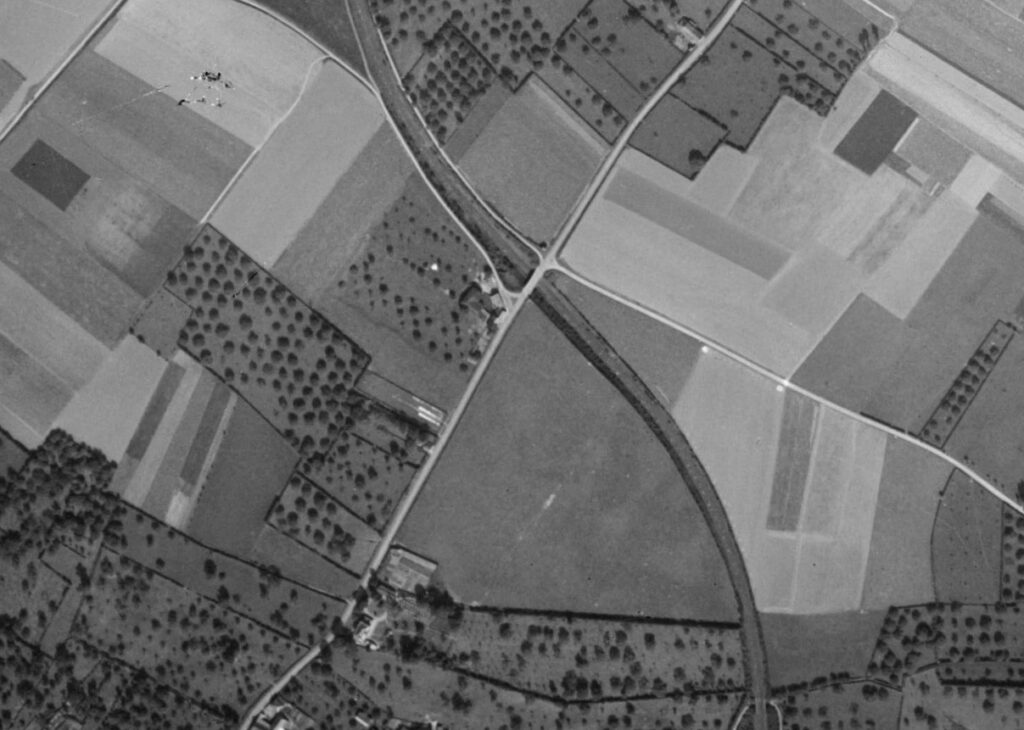
13 Sept 1949 aerial of Ghissignies, the railway embankment and crossroads
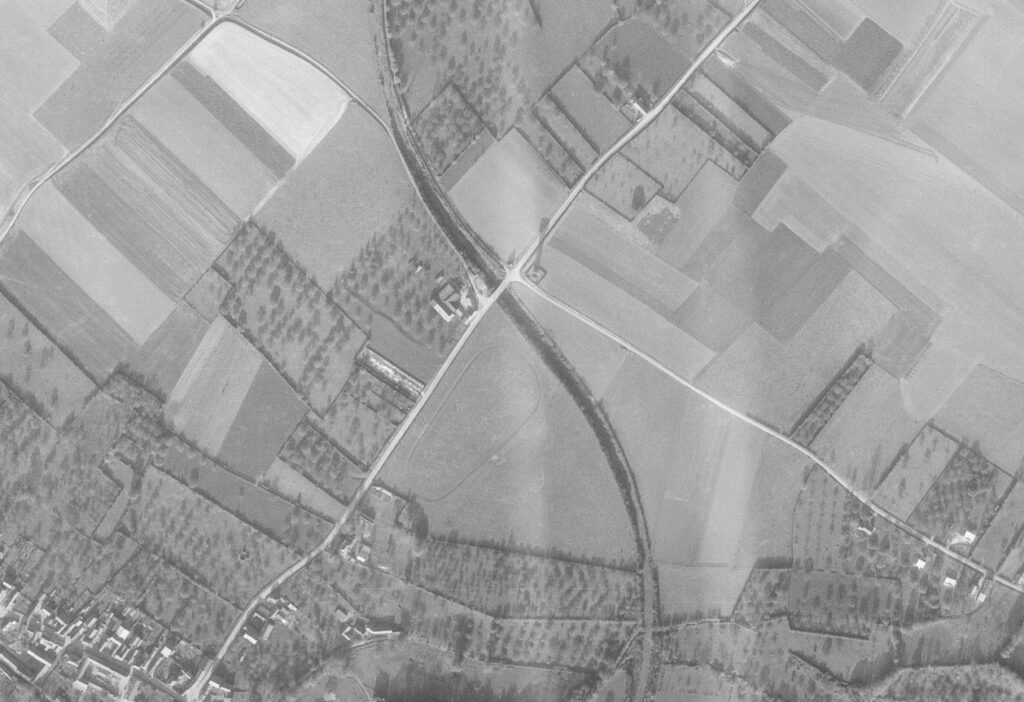
15 November 1968 aerial of Ghissignies showing water tower to the east of the crossroads
JB, 31 March 2021
New Battlefield Tour announced! ‘Western Front Footsteps’ 28 September – 1 October 2018
Following the success of 2016’s ‘Bristol on the Western Front’ and last year’s ‘The West Country at War’ tour trip that I organised with fellow historian, Clive Burlton, we are pleased to announce another trip for this coming autumn.
Stops will cover actions by units from Wiltshire, Somerset and South Wales as well as Bristol. The tour is named ‘Western Front Footsteps’.
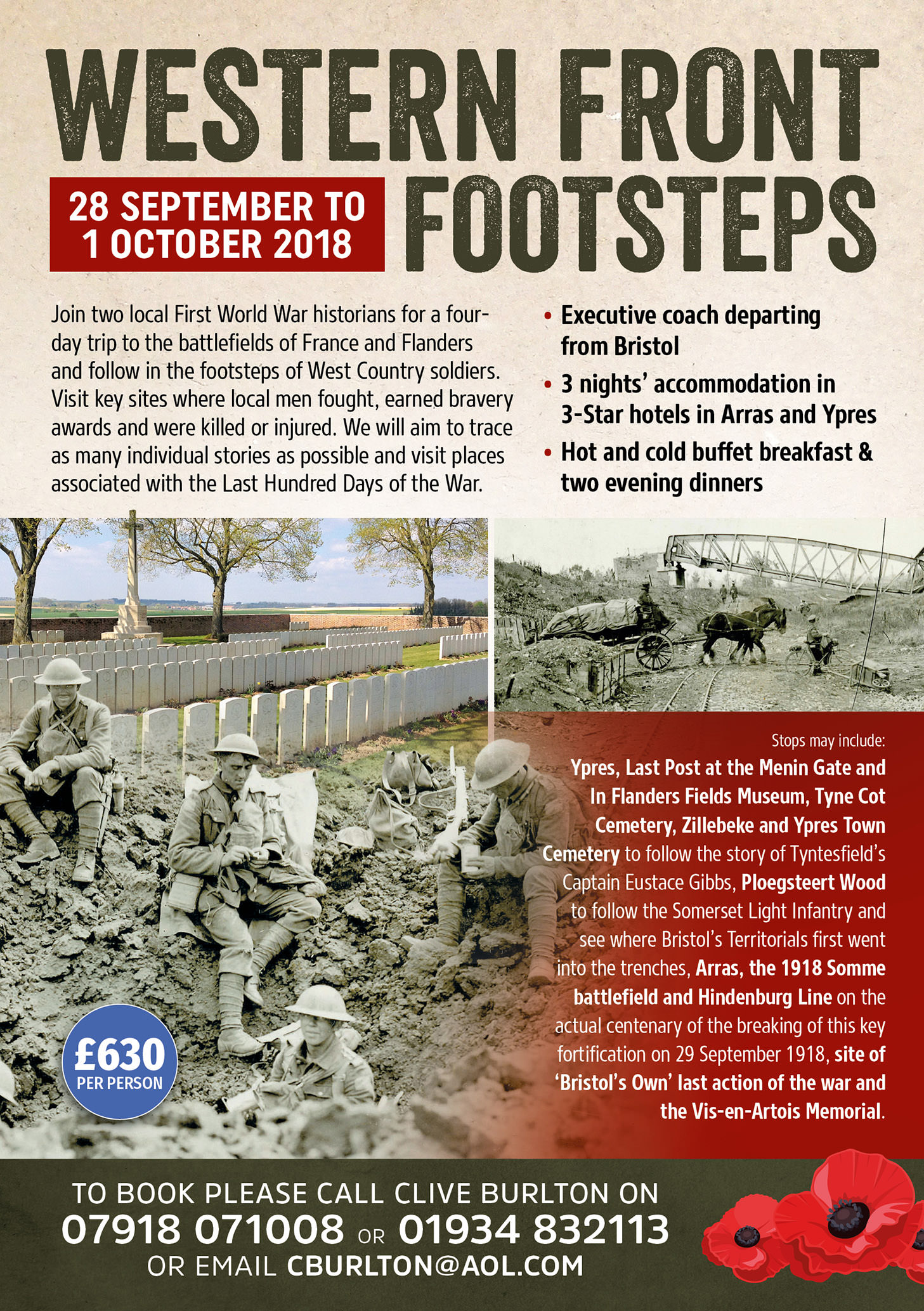
Once again we are travelling with our partners at Bakers Dolphin. The three night, four day tour will visit key sites where soldiers from the West Country fought, earned bravery awards and lost their lives.
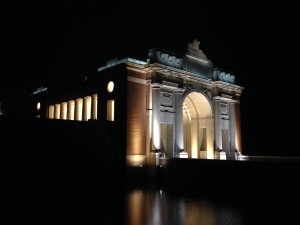
Menin Gate, Ypres
Travelling by executive coach we will depart from Bristol on 28 September and travel to Arras, stopping at sites of interest en route. The next day will be spent on the 1918 Somme battlefield on the centenary of the breaking of the Hindenburg Line – a momentous day that paved the way to allied victory. It is also the centenary of the last assault ever made by the 12th Gloucesters (Bristol’s Own) and we will walk their final attack. It will be special to visit this fascinating battlefield on such a poignant day.
On 30 September we will journey northward to the sacred Ypres salient , the wartime cauldron for so many of Britain’s soldiers. Whilst in Ypres we will attend the Last Post ceremony at the Menin Gate and visit the In Flanders Fields Museum in the Cloth Hall. Our time in Ypres will see us visiting sites around the salient including Ploegsteert (known as Plugstreet to the Tommies) to follow the 1st Somerset Light Infantry in December 1914, see where the Christmas Truce took place and visit the area in which Bristol’s Territorials first went into the trenches.

A key theme of this year’s tour will be looking into the wartime history of the Gibbs family from Tyntesfield (now a National Trust property) – their story is fascinating and heart-rending.

Ypres Cloth Hall – now the location for the In Flanders Fields Museum
Accommodation is based at the following 3-star hotels – Holiday Inn Express (Arras) and the Novotel (Ypres). Full details of cost, what is included and contact details to reserve a space can be found on the attached flyer.
We look forward to you joining us for another wonderful few days following in some Western Front Footsteps!
‘Remembering Reading’s Heroes’ – a talk at Haslams Estate Agents for Reading FC and ABF The Soldiers’ Charity
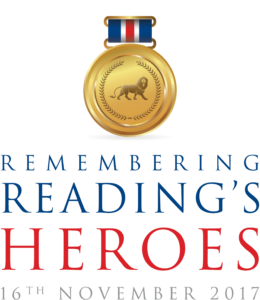
Last week I gave a talk on behalf of Haslams Estate Agents and Reading Football Club in Haslams’ flagship office in Friar Street, Reading. The talk was part of a fundraising evening for ABF The Soldiers’ Charity and was attended by over 80 people.
The evening started with drinks and canapés (based on wartime fare which included such things as spam fritters and Maconochie’s steak pies) before 25 minutes from me discussing Reading in the Great War.

Canapés were based on a wartime theme
Most of the audience had little knowledge of this period of history and I was able to explain some of the more interesting stories I had found in my research. These included the story of Max Seeberg, a former Reading FC player from the 1912–13 season who, by the time was declared in August 1914, had retired and was working as a publican. Despite being a well-known and liked member of Reading’s community his German ancestry ensured he was locked up for the duration of the war. Remarkably, he seemed to bear no malice to Britain, becoming a naturalised British subject in 1920.

Talking about Max Seeburg, a former Reading FC player who was locked up for the duration of the war due to his German nationality
I also spoke about Ronnie Poulton Palmer, the England rugby player, Trooper Fred Potts VC and the tragic case of the Sutton family (of Sutton Seeds) whose five boys went off to war. By the end of March 1918 four of them had been killed, leaving Leonard Sutton (a wartime mayor of Reading) with his sole remaining son, Noel who survived the conflict despite being torpedoed mid-channel by a German U-Boat.
After a break for more drinks and canapés an auction and raffle was held. A weekend on the battlefield with me was auctioned off by local resident, Chris Tarrant. Over £3,000 was raised for ABF The Soldiers’ Charity.
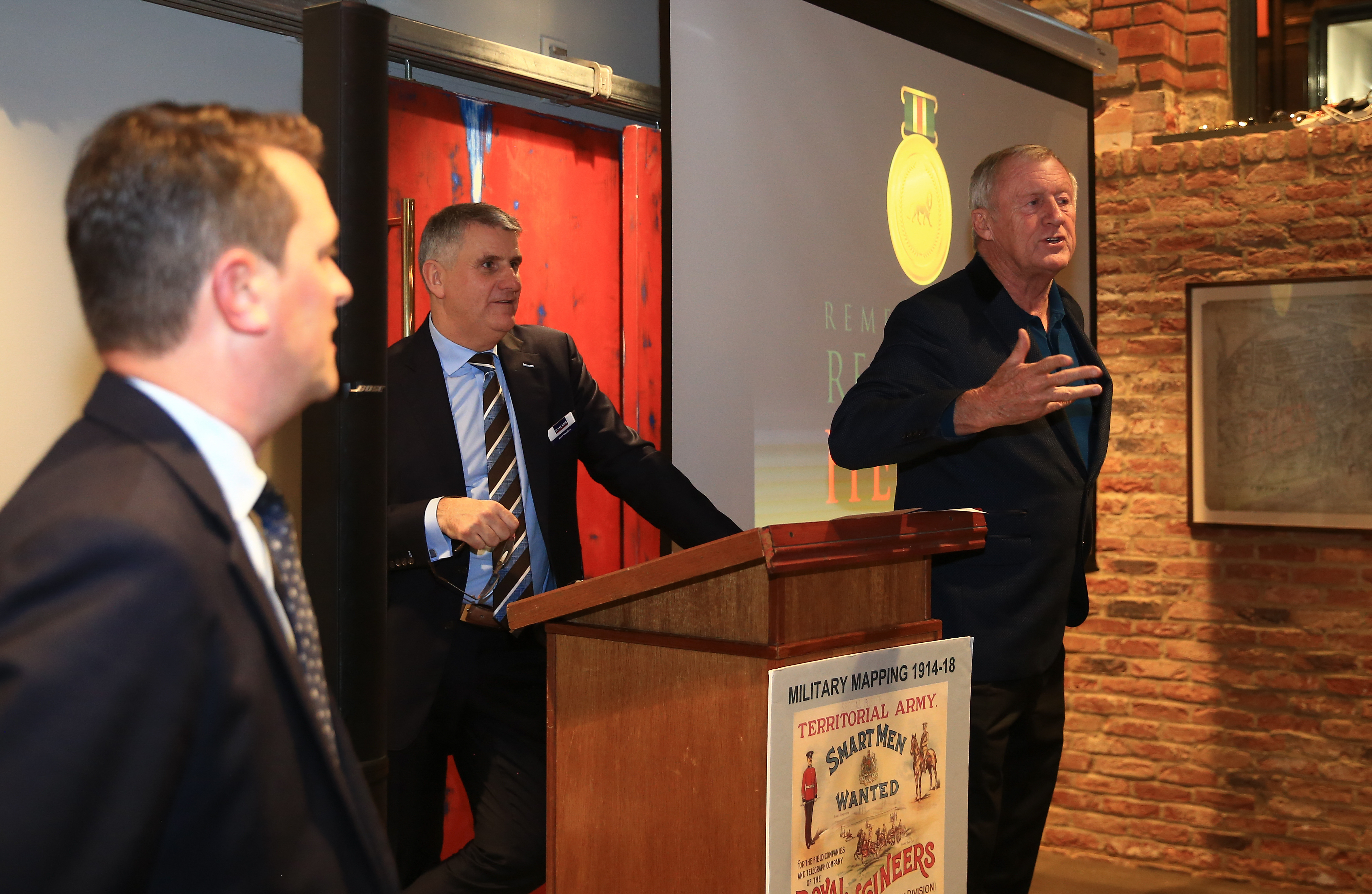
Chris Tarrant auctions a weekend on the battlefield with me to raise funds for ABF The Soldiers’ Charity
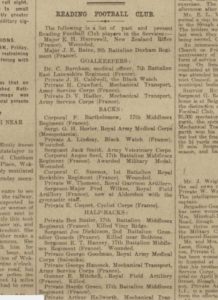
An extract from the Reading Mercury of 12 August 1916 listing players associated with Reading Football Club serving in the forces
The second half of my talk focused on telling the story of a number of Reading FC players and their wartime service. Nine former players died in the conflict whilst others such as Joe ‘Bubbles’ Bailey achieved remarkable success as a fighting officer. In Joe’s case this resulted in the award of the DSO and three Military Crosses, all in a period of just seven months in 1918!
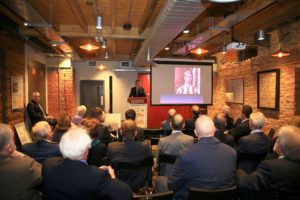
Speaking about Joe Dickenson, ‘the Footballing Grenadier’ who served in the 2nd Grenadier Guards and was killed at the Battle of Festubert in May 1915
My thanks to BBC Radio Berkshire’s Graham McKechnie, military historian Jon Cooksey and Reading FC historian Alan Sedunary who conducted a great deal of research on these players back in 2014.
The entire evening was a great success and I look forward to working with Haslams and Reading FC again in the future.
A selection of images from the evening (courtesy of Ben Hoskins http://www.bhoskins.com/) are shown below.
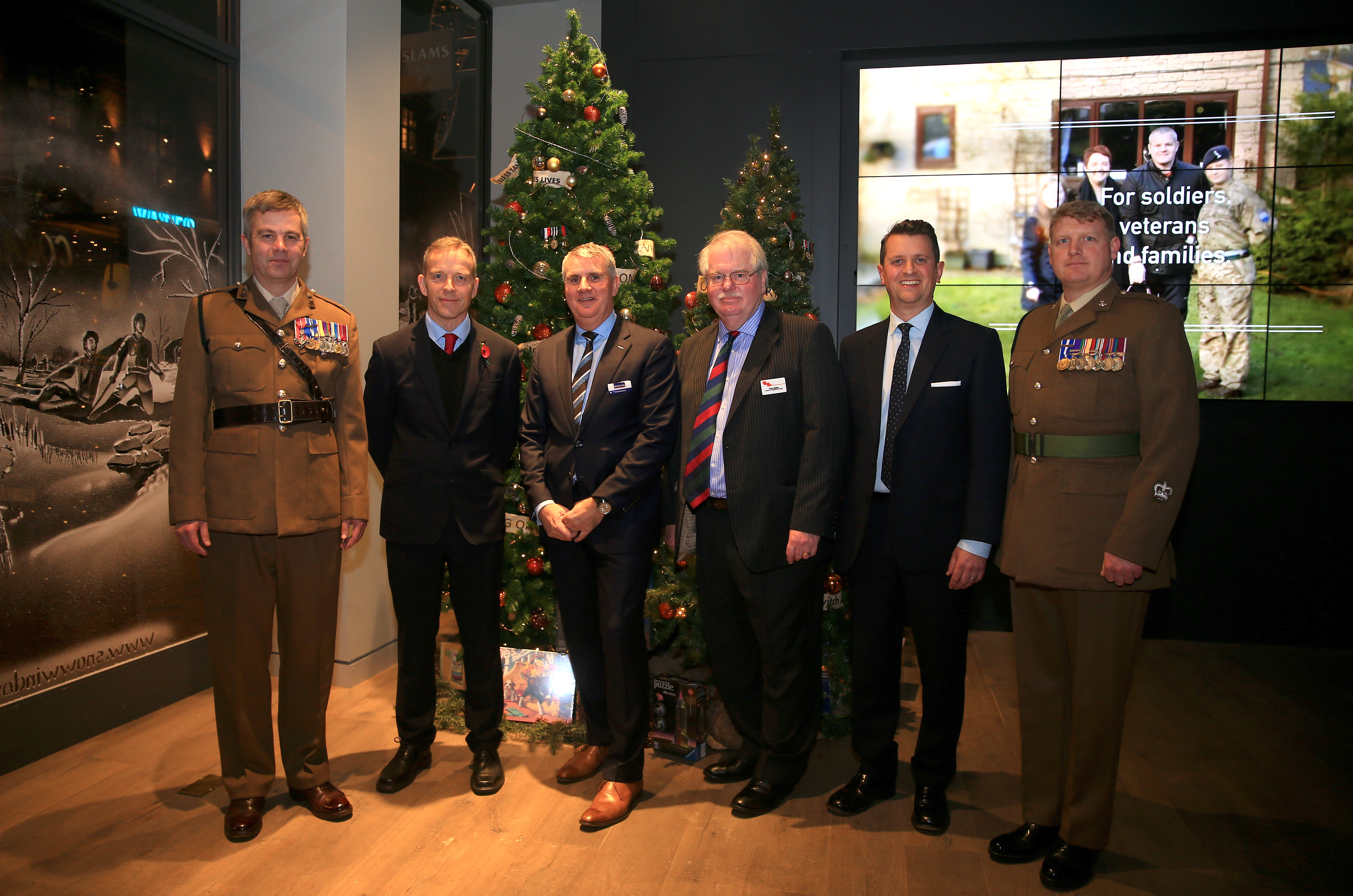
With Steve Woodford of Haslams, Brigadier Peter Walker of ABF The Soldiers Charity and serving soldiers
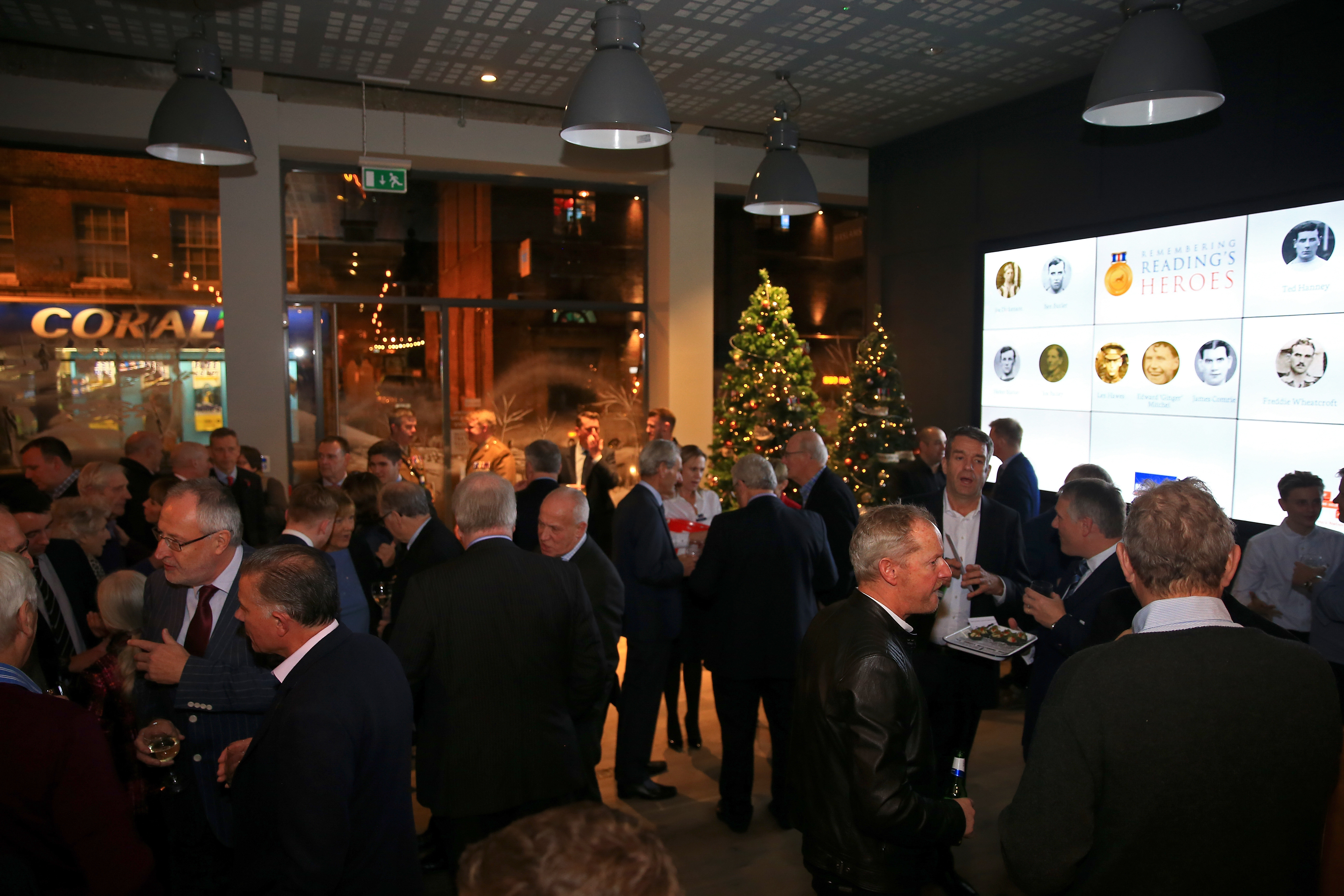
Pre-talk drinks and canapés
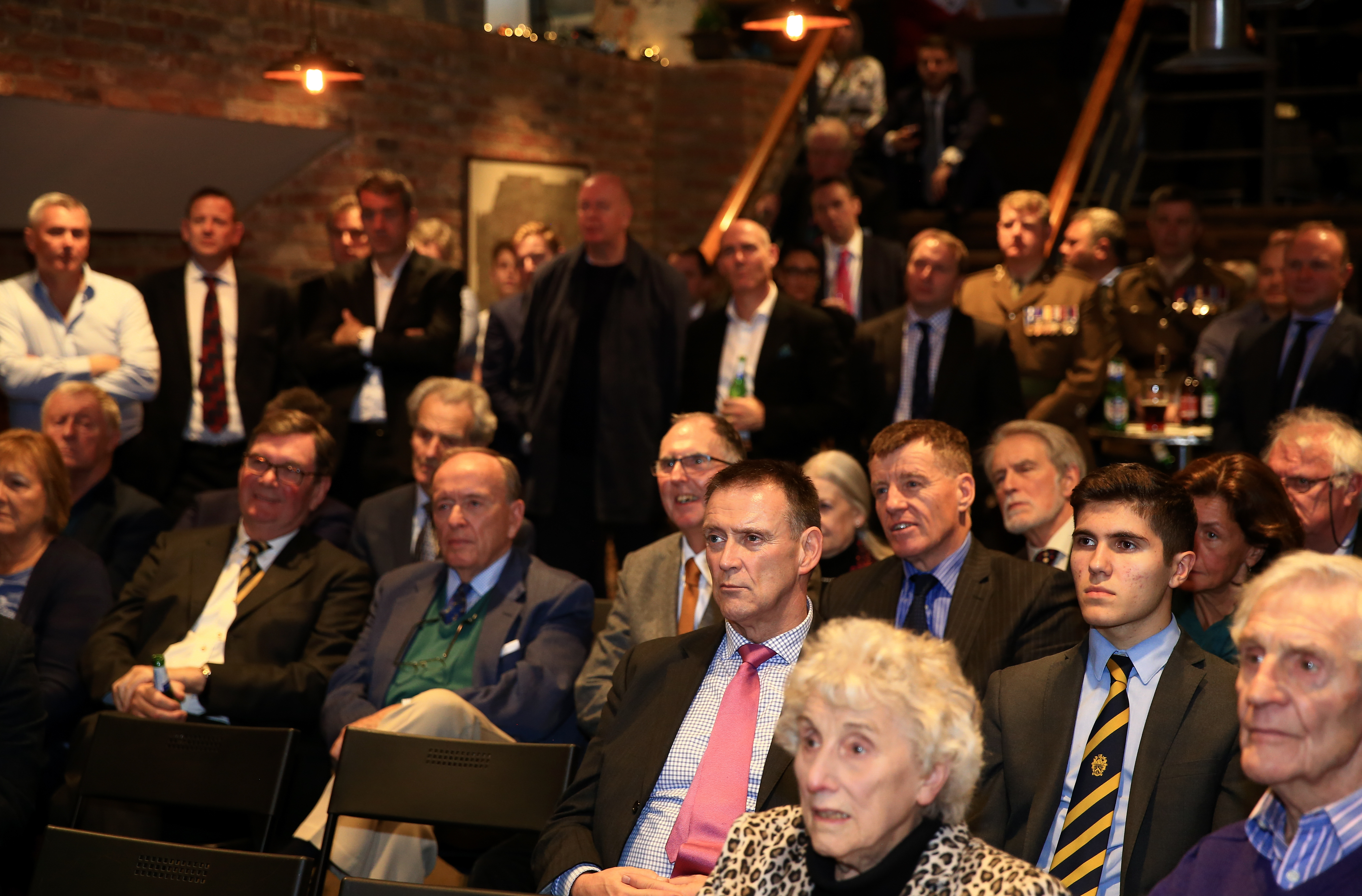
The audience seemed to enjoy the talk
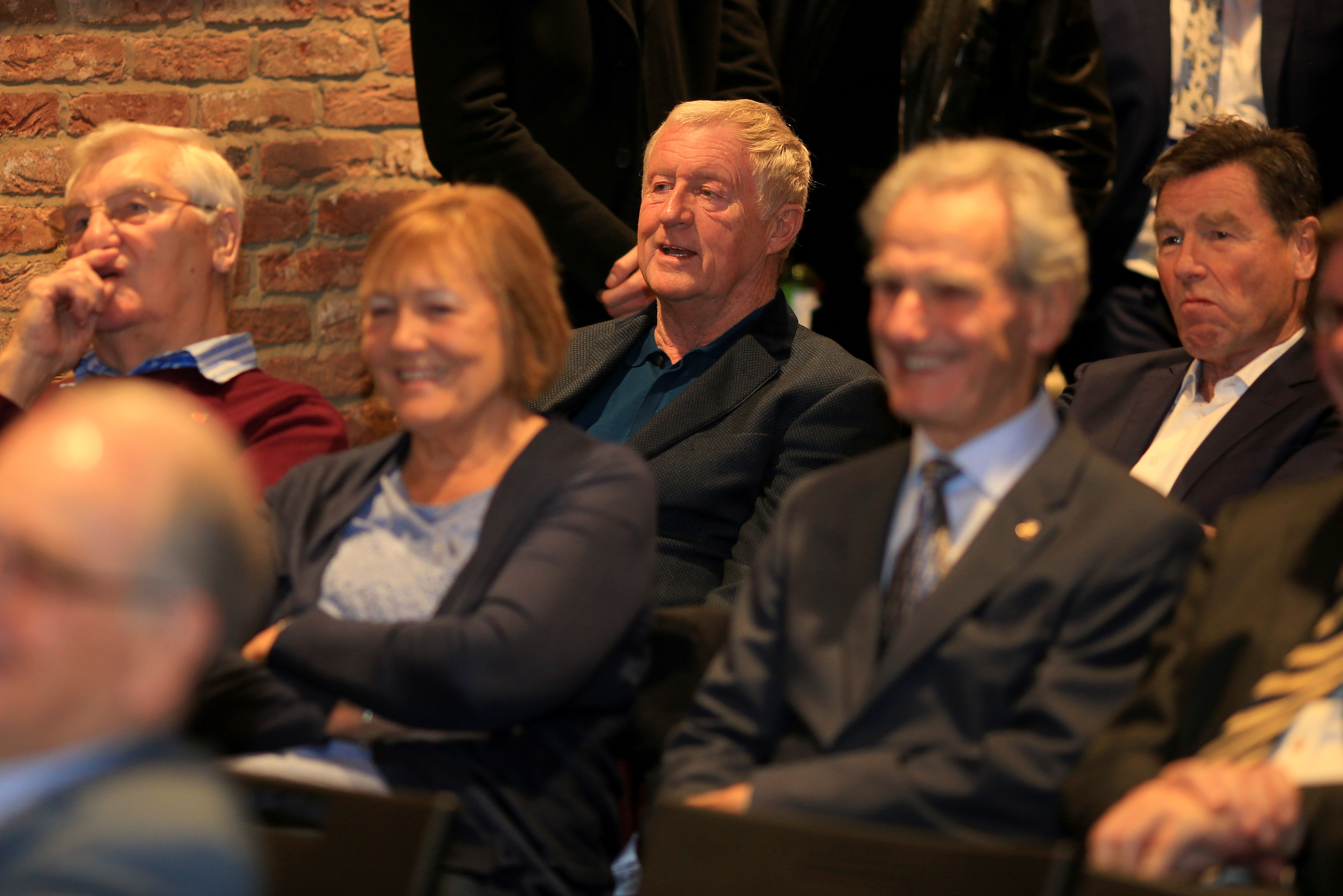
More audience shots
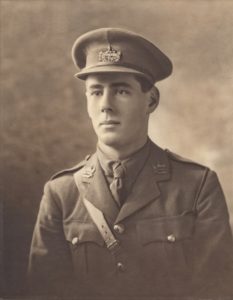
Second Lieutenant Hardy Falconer Parsons VC, 14th Gloucestershire Regiment. Image courtesy Soldiers of Gloucestershire Museum, Ref GLRRM:04750.6
Today saw the unveiling of a Bristol Civic Society blue plaque at the former Bristol home of my local Victoria Cross recipient, 2/Lt Hardy Falconer Parsons VC, 14th Gloucestershire Regiment. He lived a fifteen minute walk from my house and I have known his story for the past fourteen years that I have lived in the city.
My colleague Clive Burlton and I were determined to see Hardy’s strong association with Bristol and the West Country recognised. As his Government funded VC commemorative stone was unveiled in Rishton, Lancashire back in August we have spent the last year working on honouring Hardy’s local connections with a Bristol Civic Society blue plaque.
The plaque was unveiled by the Archie Smith and Grace Tyrrell, Head Boy and Head Girl of Kingswood School along with the Lord Mayor of Bristol, Cllr Lesley Alexander. The ceremony was attended by members of the Bristol Civic Society; the former Gloucestershire Regiment; the Soldiers of Gloucestershire Museum; the Bristol University Officer Training Corps; Kingswood School, Bath, Redland Green School and Dolphin Schools in Bristol; bandsmen from the Salamanca Band of the Rifles Regiment; members of the Western Front Association and the Bristol Great War network and representatives of the Kingswood Association, whose generous donation enabled the plaque to be made and installed. Also attending were the Deputy Lord-Lieutenant for the County and City of Bristol, Colonel Andrew Flint and the Dean of Bristol, the Very Rev Dr David Hoyle. In total, around 100 people were in attendance for the ceremony. Afterwards a sizeable number of us were invited back to the Artillery Grounds on Whiteladies Road for light refreshments as guests of Bristol University Officer Training Corps.
Images of the unveiling ceremony can found below, followed by the culmination of much detailed research into Hardy’s life by Clive Burlton and myself. I can only hope that the people of Bristol and Bath embrace his memory. He deserves that.
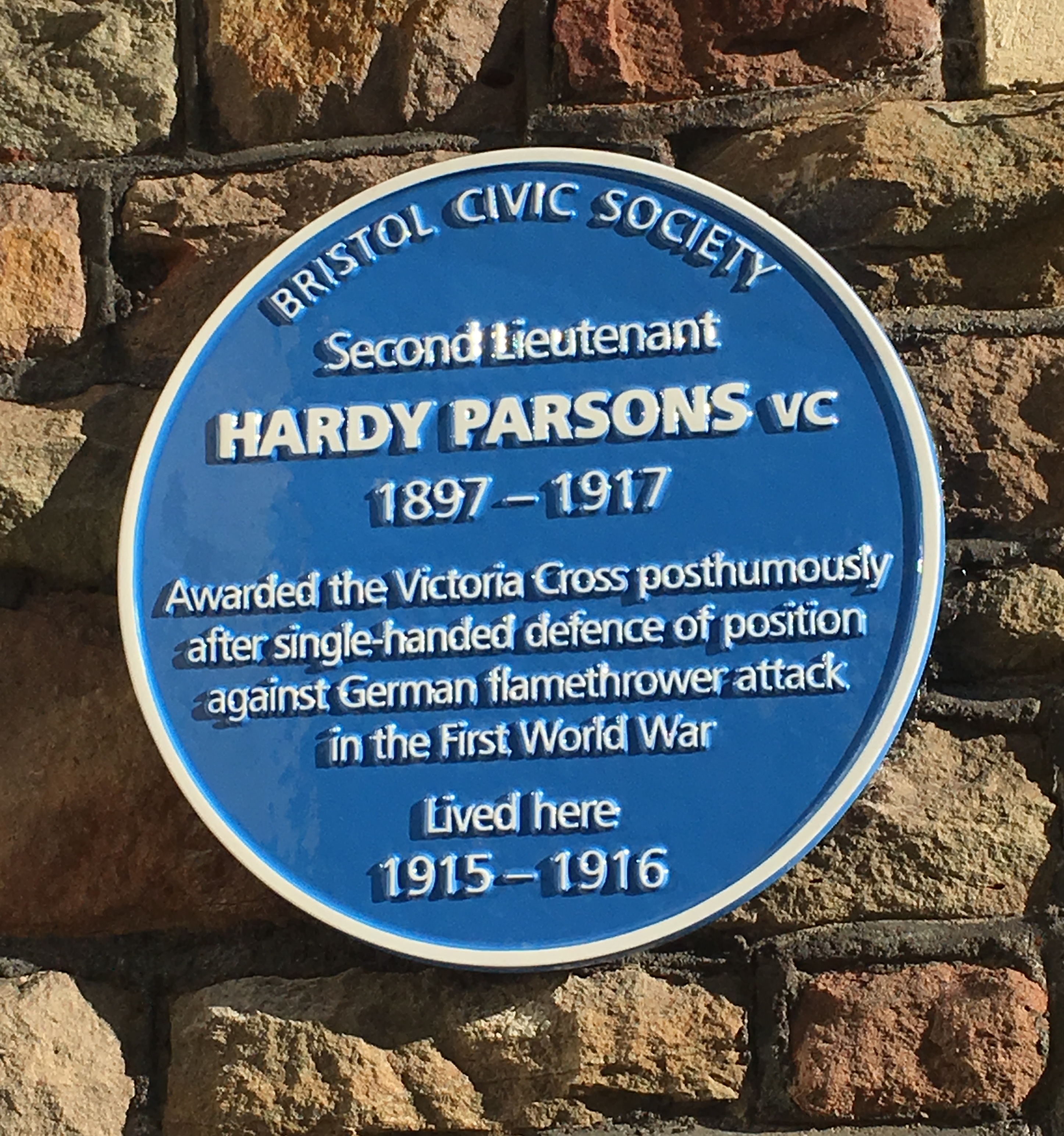
Blue plaque for Hardy Falconer Parsons VC at 54, Salisbury Road, Redland, Bristol
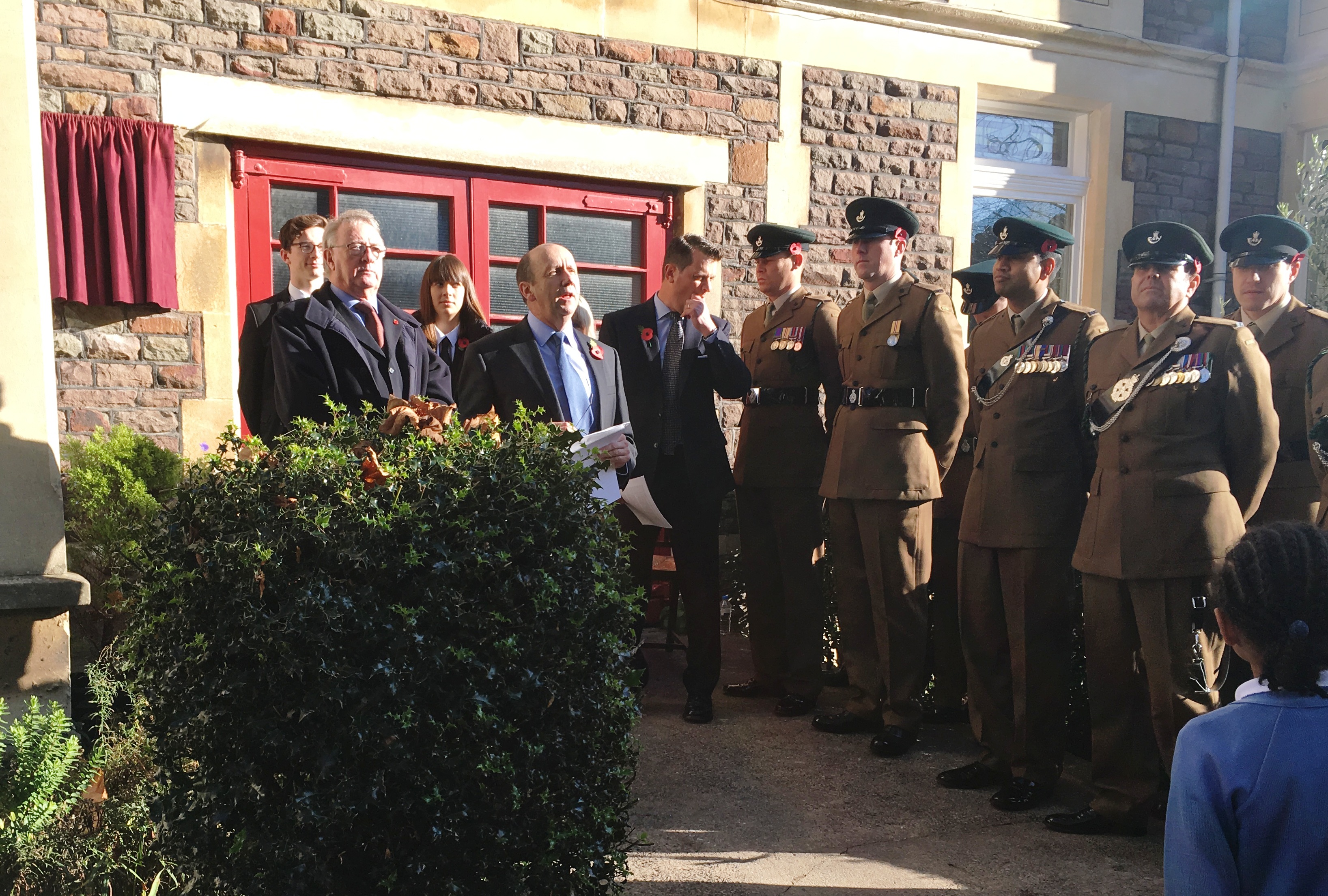
Clive Burlton gives the opening address
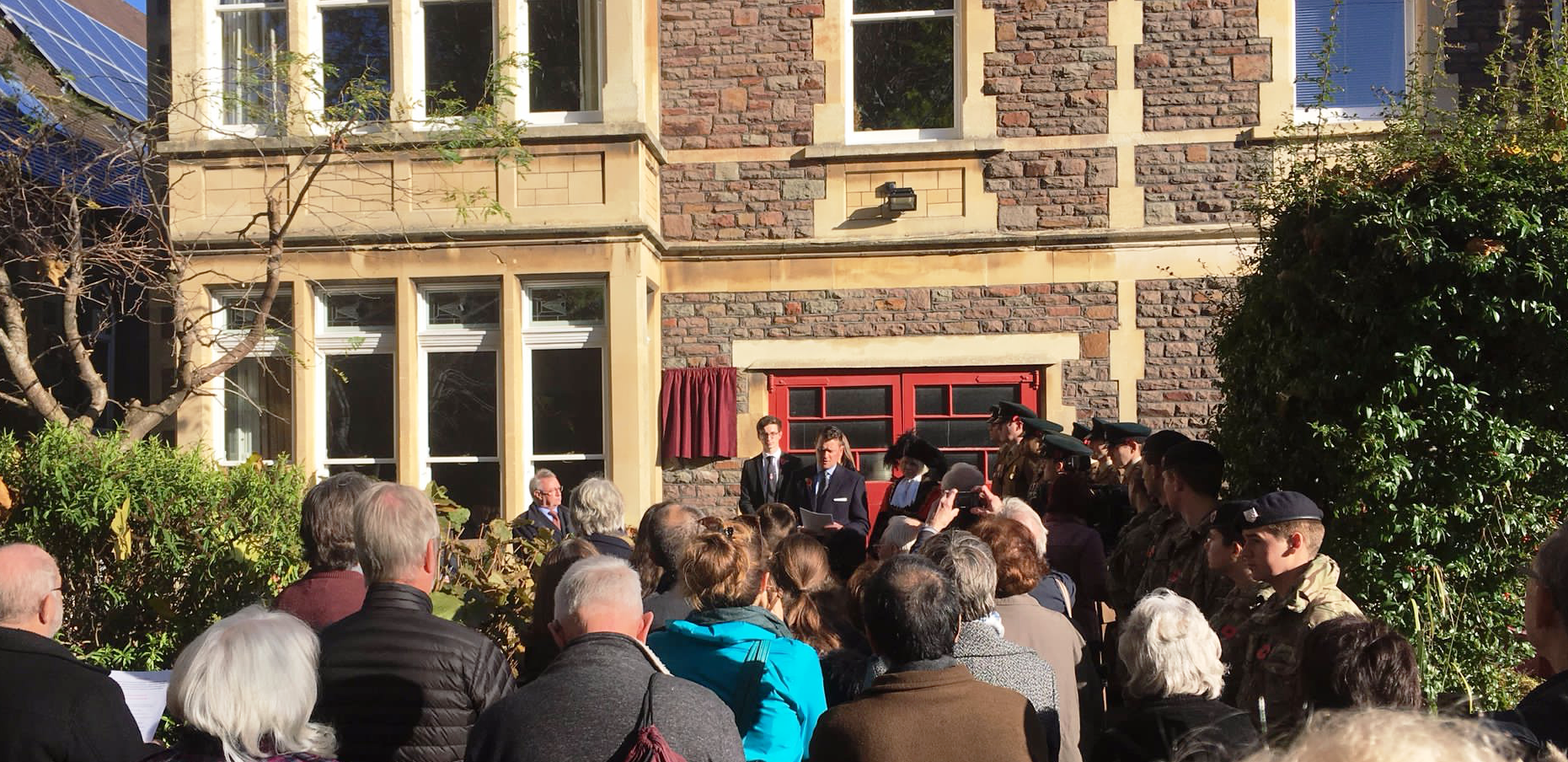
Jeremy Banning providing the historical background to the life of Hardy Falconer Parsons VC
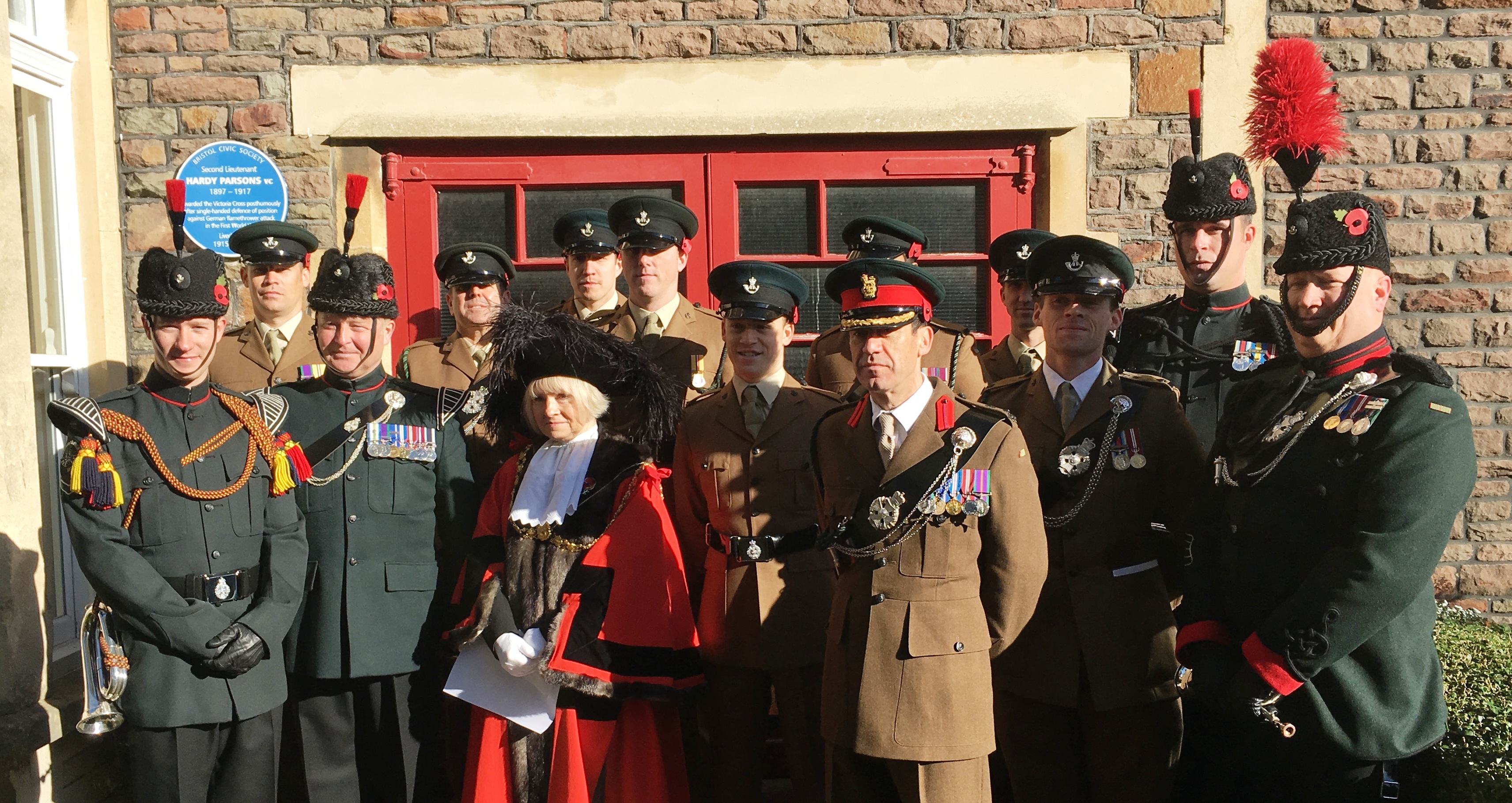
The Lord Mayor of Bristol with members of Bristol University Officer Training Corps and bandsmen from the Salamanca Band of the Rifles
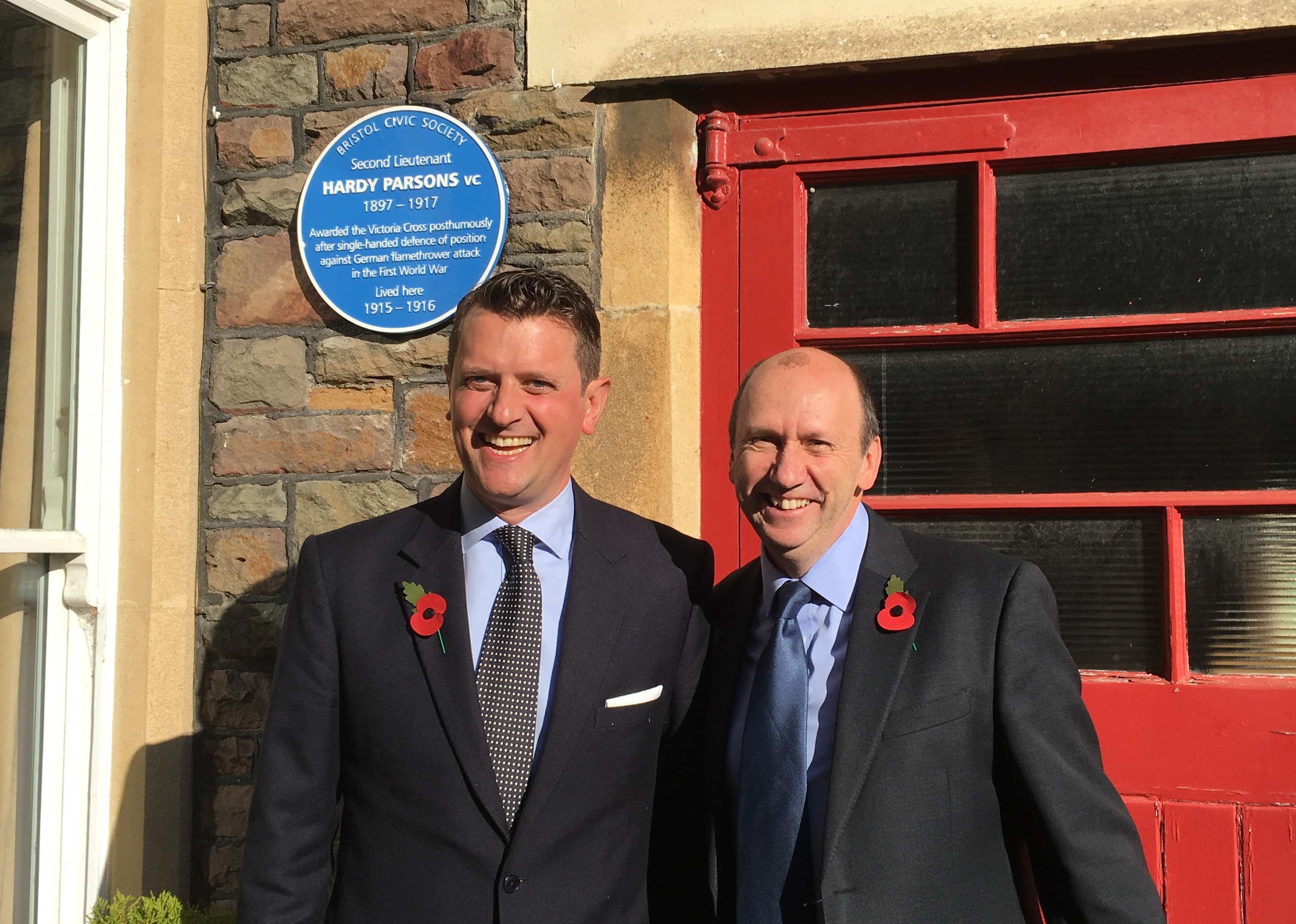
A delighted Jeremy Banning and Clive Burlton with Hardy’s new blue plaque
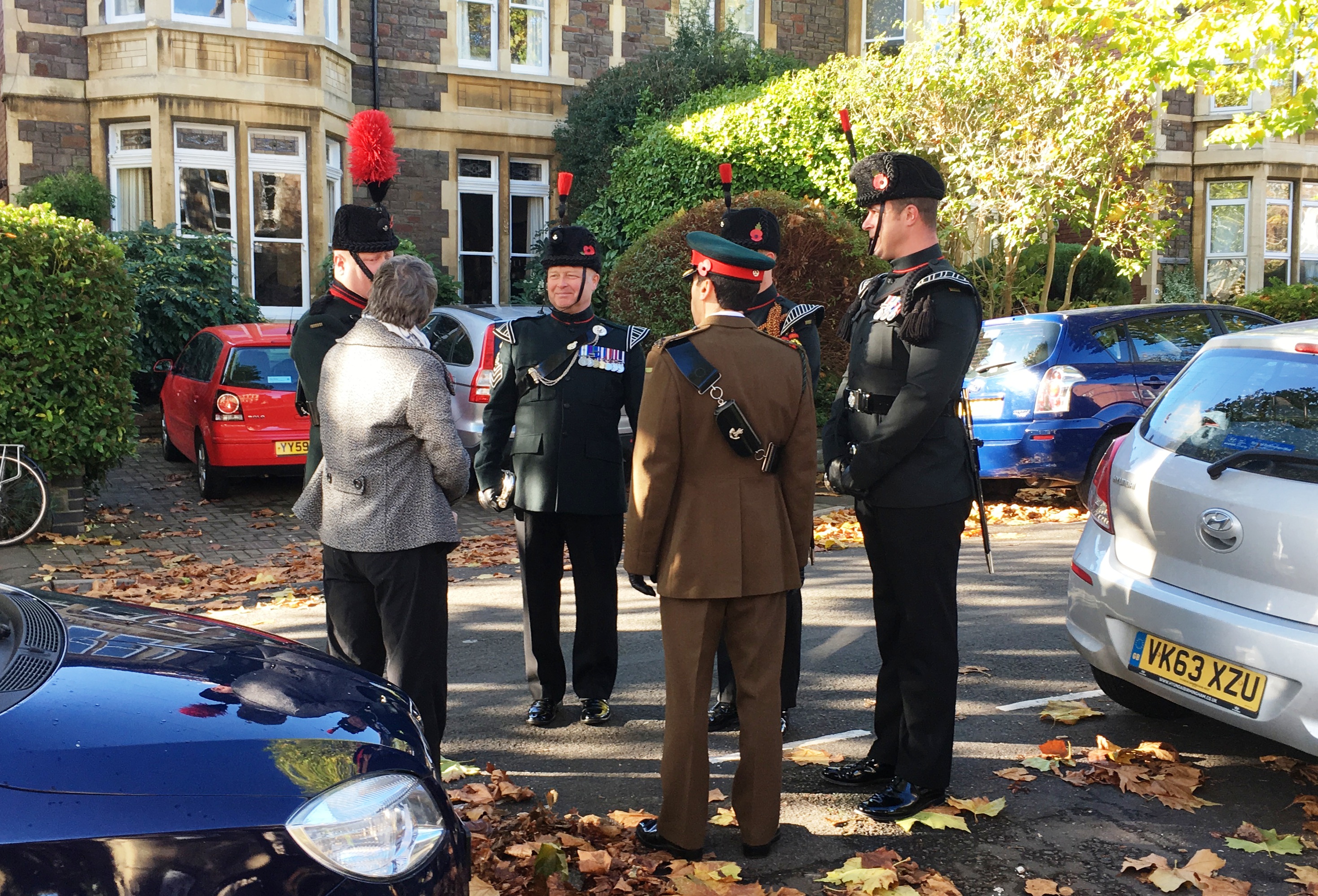
The ceremony was well attended by the military
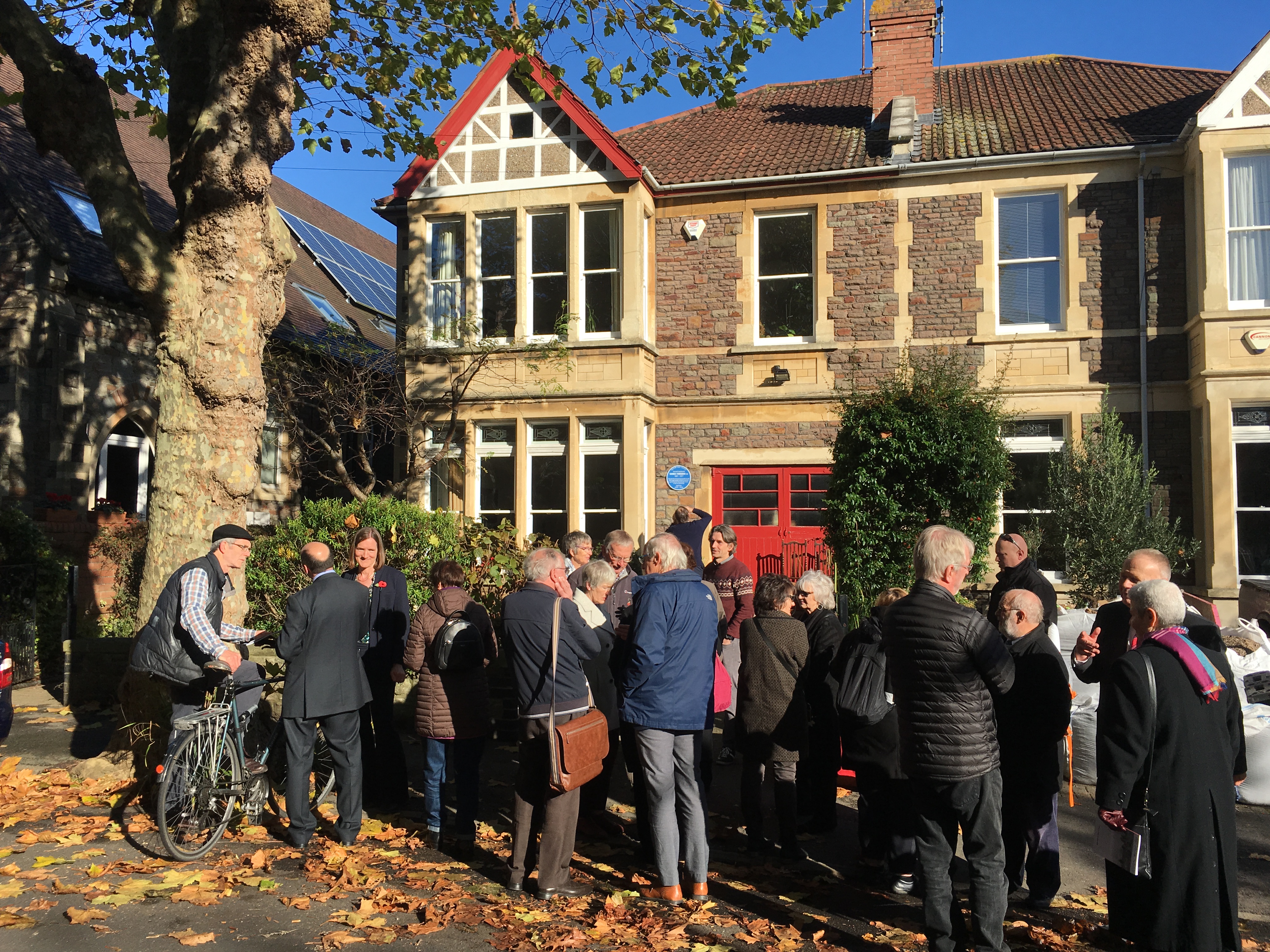
After the ceremony many of those attended were able to mingle and discuss Hardy’s life
Bristol 24/7 have also covered the story: https://www.bristol247.com/news-and-features/news/pictures-blue-plaque-revealed-wwi-soldier-redland/ as have BBC News: http://www.bbc.co.uk/news/uk-england-bristol-41918314. Our BBC Points West interview is available for a week from 16 minutes in here: https://www.bbc.co.uk/iplayer/episode/b09bzw5f/points-west-evening-news-08112017
The life of Hardy Falconer Parsons VC, 14th Battalion, Gloucestershire Regiment
Hardy Falconer Parsons was born on 30 June 1897 at Rishton, near Blackburn, Lancashire, the first of three boys. His father, the Rev James Ash Parsons, was a Wesleyan Minister whilst his mother Henrietta (known as Rita) was the daughter of a railway inspector from York. Hardy’s rather unusual middle name came from Rita – Falconer was her maiden name.
The Rev James Ash Parsons had spent eleven years in total in the slums of East London as superintendent of the Methodist Leysian Mission. Ill health forced him and Rita to St Anne’s on Sea, south of Blackpool and it was whilst living here that Hardy was born. There followed three years at Arnside immediately south of the Lake District. Clearly, the ethos of duty and service to others, so well practiced by his parents, was a huge part of Hardy’s upbringing.
Hardy’s first school was King Edward VII School at Lytham St Annes. From the paper work we have found it appears the family moved to Bristol in 1912 when the Rev James Ash Parsons became pastor at the Old King Street Wesleyan Chapel (sadly, now demolished). The family moved to 54 Salisbury Road in Redland and Hardy attended Kingswood School in Bath until April 1915.
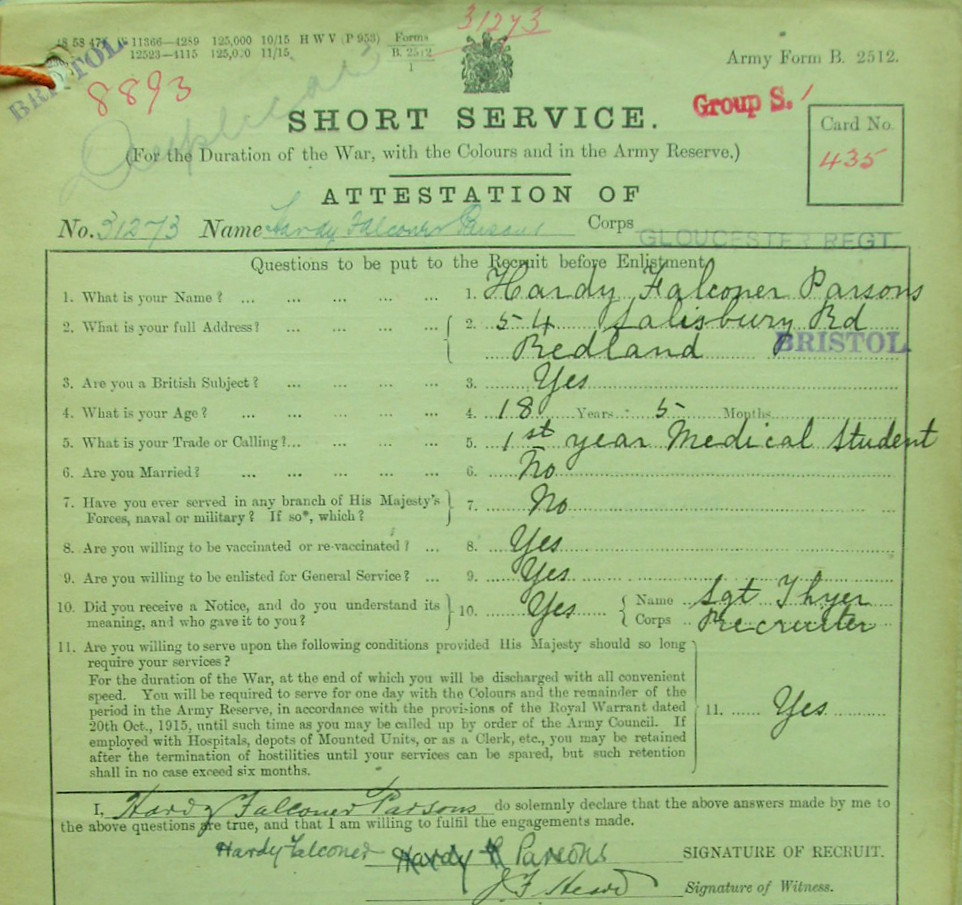
Extract from attestation papers of Hardy Falconer Parsons (National Archives: WO339/73298)
After school Hardy Parsons became a Medical Student at Bristol University with the aim of becoming a medical missionary. At the end of November 1915, during his first year at the University he signalled his wish to volunteer for service by attesting when aged just 18 years & 5 months but was immediately placed on the Army Reserve.
He had previously declined a safe post in a Government munitions laboratory, feeling that he ought not to withhold himself from the fullest sacrifice. He hated war, but recognised that the making of munitions was just as much war work as was the actual taking of life.
He joined the University’s Officer Training Corps in May 1916, a month shy of his 19th birthday, and then passed his first Bachelor of Medicine degree. His attestation papers make interesting reading – recording that he was a tall man, especially for that time, standing at 6ft ¾ inch tall. In early October 1916 he was posted to 6th Officer Cadet Battalion at Balliol College, Oxford and, on 25 January 1917, was appointed to the Gloucestershire Regiment as a Second Lieutenant.
He eventually joined the 14th Battalion in March, a unit which had previously been a ‘Bantam’ battalion – with men of 5ft 3 inches and less serving in its ranks. By the time the nearly 6ft 1 inch Hardy joined the battalion this unique distinction had been very much diluted. In February 1917 the battalion war diary records 475 ‘normal size men’ joining the battalion.
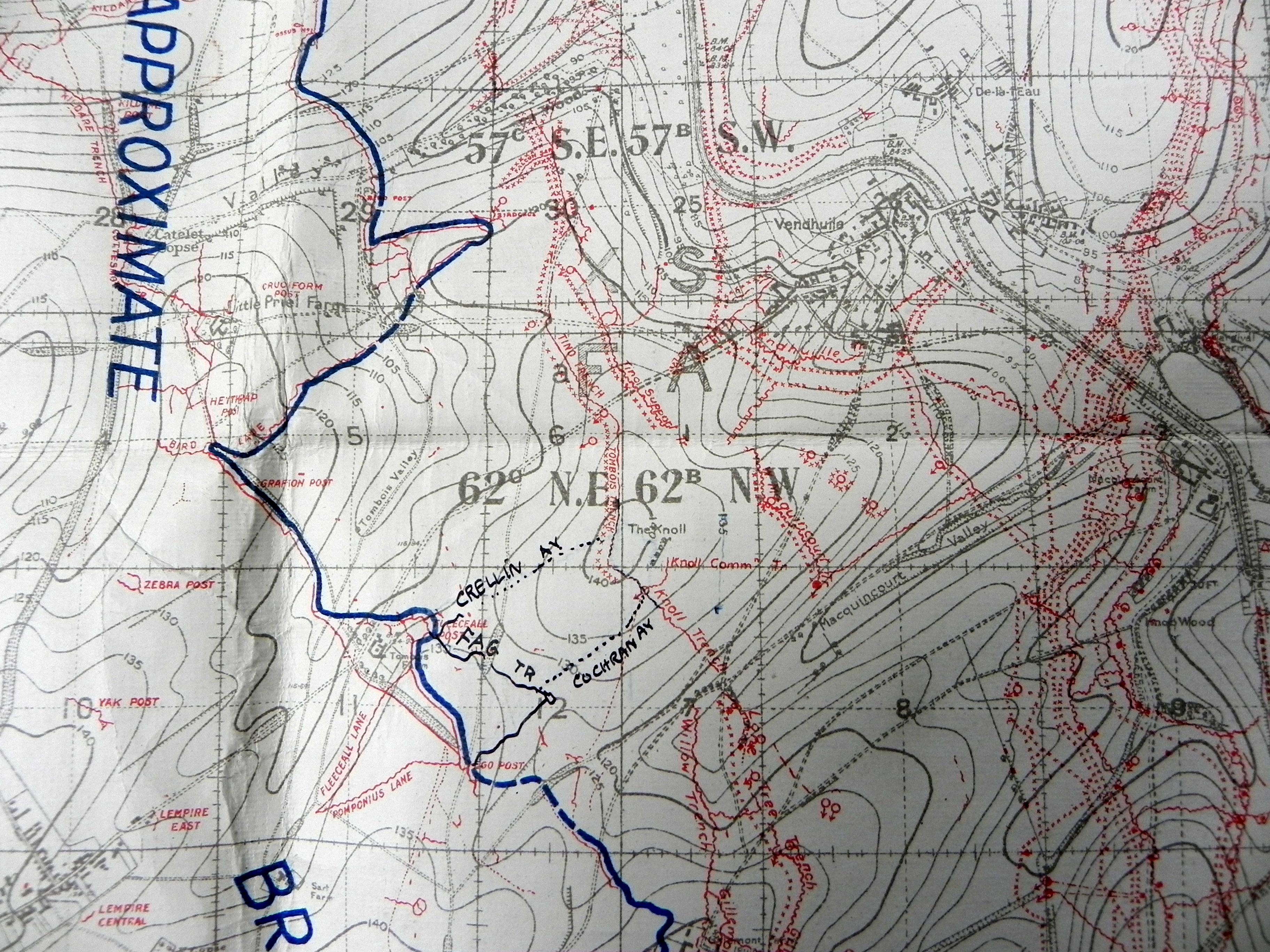
Trench map extract of The Knoll – captured by 105 Infantry Brigade on 19 August 1917
On 21 August 1917 near the village of Vendhuile in the eastern part of the Somme, Hardy’s battalion were holding recently captured trenches at a position known as The Knoll in the Hindenburg Line outpost zone. Their relief of the units who had captured the Knoll some two days before was completed by 1.30am that night.
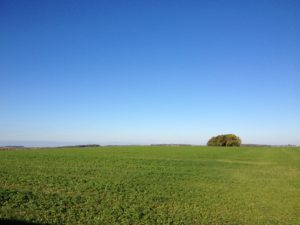
Modern view of The Knoll, photographed October 2017. Vendhuile, the Hindenburg Line and St Quentin Canal are out of view in the valley.
It was a critical position which afforded observation over the Hindenburg Line and St Quentin canal a mile away – observation the British wanted and the Germans wanted to prevent. In fact, men from Bristol’s 1/4th and 1/6th Territorial battalions had fought for the same view in this same position four months previously.
The loss of such critical terrain forced the Germans into a devastating counter-attack. As recorded in the Brigade war diary, at 3.51am the Germans struck. Militarily, it was a brilliantly executed counter-attack by the Germans – The Knoll being attacked at four points simultaneously. German infantry were accompanied by special detachments using portable flamethrowers. These forced Hardy Parsons’ men back. However, he alone stuck to his bombing post and held his position, throwing bombs (hand grenades) at approaching Germans until a British counter-attack could be launched. The counter-attack was successful – the Germans were repulsed from the trenches around The Knoll and within 40 minutes this bloody action was over. Much of this success is due to Hardy’s refusal to yield ground.
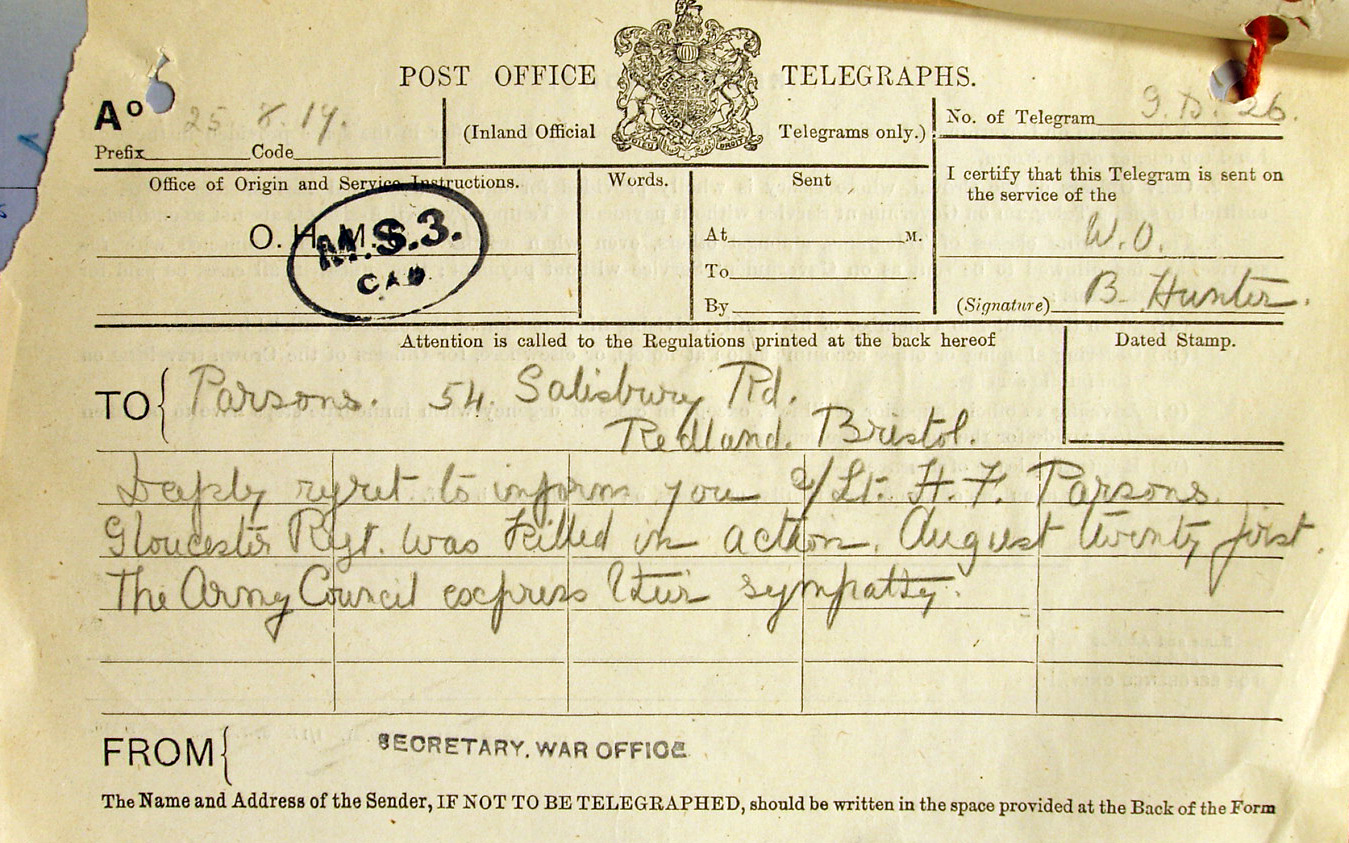
Telegram sent to the Rev James Ash Parsons informing him of Hardy’s death
During his heroic sole defence of The Knoll Hardy had been severely burnt by liquid fire. Writing these words over a hundred years later I cannot begin to imagine the sense of duty that compelled him to stay at his post, or the pain he would have endured during and after sustaining such horrific burns. Unsurprisingly, the nature of his wounds proved too severe and he succumbed later that day, dying at the age of just 20 years and two months. Hardy Falconer Parsons is buried in the immaculate CWGC cemetery at Villers-Faucon.
N.B. I was contacted in August 2019 by Dr Markus Schroeder whose great great uncle, Ernst Komander, served with the 2./Jäger 6, Jäger-Regiment 6, 195 Infanterie-Division. He tells me that regimental records show it was Jäger-Regiment 6 that led the attack on the 14th Gloucesters with the specialist flamethrowers employed by Sturmbataillon 3. Ernst Komander was wounded on the day of the attack and died of those wounds two days later. He is buried in Block 2, Grave 56 in Caudry German Military Cemetery.
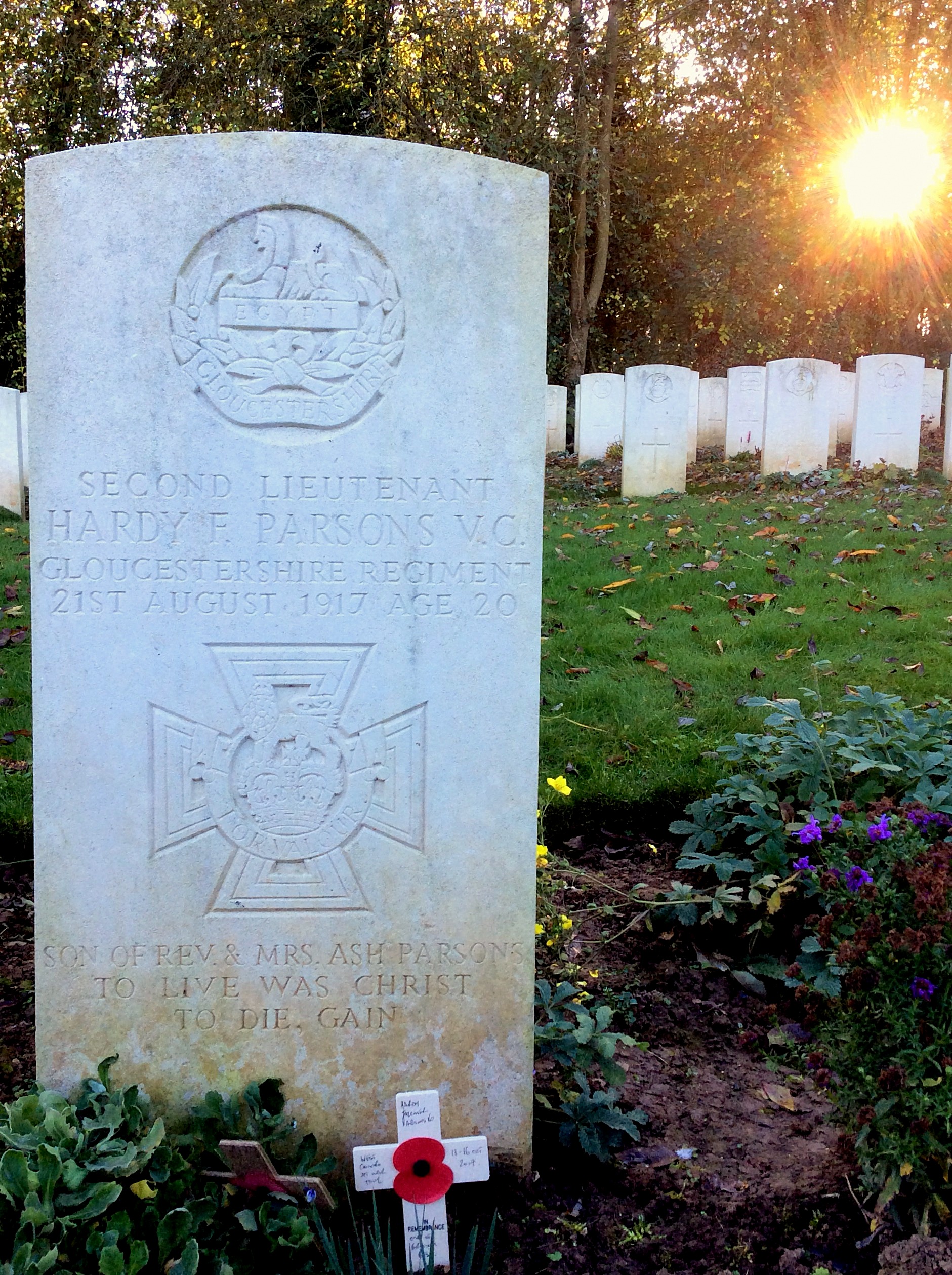
Grave of Hardy Falconer Parsons VC at Villers Faucon Communal Cemetery
Hardy’s effects, consisting of just a wrist ID disc and two wrist watches were sent by registered post to his father within the month.

105 Infantry Brigade war diary describing the events of 21 August 1917
The Brigade diary describes Hardy’s gallantry, commenting that he ‘was afterwards recommended for the VC for his action’. During the war many acts of bravery were put forward for the VC but subsequently rejected. However, in Hardy’s case, approval was given. He was posthumously awarded the Victoria Cross – personally presented to his father by King George V at a ceremony on Durdham Down (Bristol) on 8 November 1917. Hardy’s father also attended the Colston Hall event on 15 February 1919 when he was presented, on his dead son’s behalf, with an illuminated address and gold watch by Lord Mayor Twiggs. The address included Hardy’s full Victoria Cross citation:
“For most conspicuous bravery during a night attack by a strong party of the enemy on a bombing post held by his command. The bombers holding the block were forced back, but Second Lieutenant Parsons remained at his post, and, single-handed, and although severely scorched and burnt by liquid fire, he continued to hold up the enemy with bombs until severely wounded. This very gallant act of self-sacrifice and devotion to duty undoubtedly delayed the enemy long enough to allow the organisation of a bombing party, which succeeded in driving back the enemy before they could enter any portion of the trenches. This gallant officer succumbed to his wounds.”
Hardy Parsons was only the second member of the Gloucestershire Regiment to receive a VC during the First World War.

Hardy Falconer Parsons VC Chapel Memorial, Kingswood School, Bath
On 23 July 1923, a tablet in his memory was unveiled in the chapel of Kingswood School in Bath and his Victoria Cross and campaign medals are held by the Soldiers of Gloucestershire Museum, having been presented to the Gloucestershire Regiment at a ceremony in 1970 in front of what is now City Hall, attended by the Lord Mayor, Cllr Bert Wilcox.
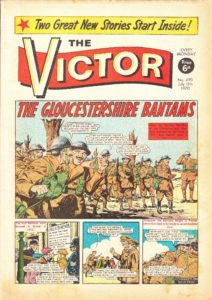
Victor comic, 11 July 1970 – the story of Hardy Falconer Parsons VC
The collection also includes a portrait photograph of Hardy in uniform; the bronze memorial plaque sent, popularly known as the “Dead Man’s Penny” to his parents after the war and his Gloucestershire Regiment collar badge. Engraved on the back of the badge are the words “Irene Randall 10 Newfoundland St., Bristol 1917”. Who she was, and why he had that, we will probably never know….
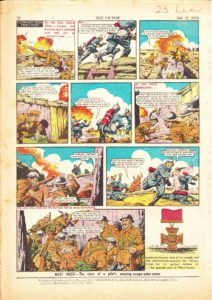
Victor comic, 11 July 1970 – the story of Hardy Falconer Parsons VC
On 11 July 1970, the Victor Comic ran a cartoon story with 10 sketches on its front and back pages, recounting the story of the 14th Gloucesters action at The Knoll and to the deeds of Hardy Falconer Parsons – bringing his heroic actions to the attention of a younger audience.
Ewart Moulton Parsons
And as for the Parsons family, despite Hardy’s death, the war had not finished with them. Hardy had two younger brothers; Ewart Moulton and Lyall Ash. Lyall was born too late to serve but Ewart, born the year after Hardy, was working as an apprentice engineer at Bristol company, Brecknell Munro and Rogers in summer 1916.
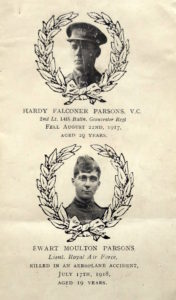
Page from memorial booklet for Hardy and Ewart Parsons
He joined the Royal Flying Corps in 1917 and by 17 July 1918, was a 19 year old Lieutenant and pilot in No.50 Training Depot Station at Eastbourne, flying his Sopwith F1 Camel fighter high above the Seaplane Station. What happened next is still unclear but his plane went into a spin and plummeted to the ground from 3000ft. Unsurprisingly, Ewart was killed instantly.
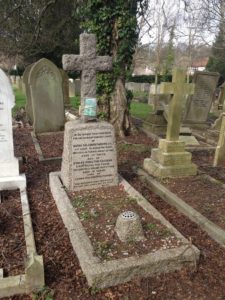
Grave of Ewart Parsons in Canford Cemetery, Bristol
His body was brought back to Bristol and his funeral held at the Old King Street Wesleyan Chapel where his father was the pastor. The coffin was borne by six RAF officers and taken on a gun carriage to Canford Cemetery, where the internment took place followed by the sounding of the Last Post.
So, in the space of eleven months James Ash and Rita Parsons had lost two of their three boys. On the base of the stone cross marking Ewart’s grave at Canford Cemetery the family also commemorated his brother, Hardy. Like so many families across the world, the Parsons’ suffered grievously in the war.
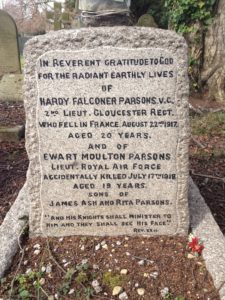
Detail on Ewart Parsons’ grave in Canford Cemetery
But, as this research is primarily based on Hardy I would like to end with a description of him, provided by his father which, when considered alongside his Victoria Cross action, shows him to have been a truly remarkable young man, a perfect example of the loss of the best of that generation:
“Hardy lived all of his life from early childhood on the same high plane of self-forgetfulness and sacrifice in his thought for and service of others”
Hardy Falconer Parsons VC (30 June 1897 – 21 August 1917)
Sources of information consulted for this article include:
Service record of Hardy Falconer Parsons VC (National Archives: WO339/73298)
105 Infantry Brigade War Diary (National Archives: WO95/2486)
14 Battalion Gloucestershire Regiment War Diary (National Archives: WO95/2486)
RAF service record of Ewart Moulton Parsons
Census returns (1901 & 1911)
Material from the Soldiers of Gloucestershire Museum http://www.soldiersofglos.com/
Victor Comic, 11 July 1970
London Gazette – various dates
The Kingswood Magazine, Vol. XX, No.10, December 1917
North Devon Journal, 27 August 1931
North Devon Journal, 10 November 1949
Gliddon, Gerald, VCs of the First World War: Cambrai 1917, Stroud, 2004

Second Lieutenant Hardy Falconer Parsons VC, 14th Gloucestershire Regiment. Image courtesy Soldiers of Gloucestershire Museum, Ref GLRRM:04750.6
On 8 November 2017 a Bristol Civic Society Blue Plaque for Hardy Falconer Parsons VC, 14th Gloucestershire Regiment (my local Victoria Cross recipient) will be unveiled at 54 Salisbury Road, Redland, Bristol. The date is 100 years to the day after King George V personally presented Hardy’s VC to his father, Rev James Ash Parsons at a ceremony on Durdham Downs.
Between 2014 and 2019 the Government is funding the production and placing of a commemorative stone for each and every Victoria Cross recipient of the First World War. Although Hardy Falconer Parsons lived at 54 Salisbury Road, he was not born in Bristol. So in August the government-funded commemorative stone relating to Hardy Parsons, was laid in Rishton, Lancashire.
Local historian and author Clive Burlton and I were determined to see Hardy’s strong association with Bristol and the West Country recognised. If we couldn’t have the government-funded stone in Bristol, the next best thing was to have a Bristol Blue plaque unveiled in his honour.
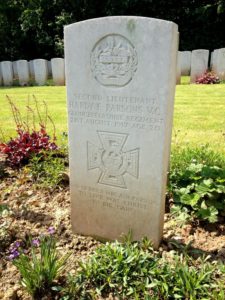
The grave of Hardy Falconer Parsons VC at Villers-Faucon Communal Cemetery
So, during the past year we have organised for the creation of the plaque. Wednesday’s ceremony, starting at 11am, will have representatives from the Bristol Civic Society; the former Gloucestershire Regiment; the Soldiers of Gloucestershire Museum; the Bristol University Officer Training Corps; Kingswood School, Bath, Redland Green School and Dolphin Schools in Bristol; bandsmen from the Salamanca Band of the Rifles Regiment; the Western Front Association; members of the Bristol Great War network and representatives of the Kingswood Association, whose generous donation enabled the plaque to be made and installed. Also attending are the Lord Mayor of Bristol, Cllr Lesley Alexander; the Deputy Lord-Lieutenant for the County and City of Bristol, Colonel Andrew Flint and the Dean of Bristol, the Very Rev Dr David Hoyle.
The event is open to the public so please do come along and attend if you can. I will be posting the results of my research on Hardy Parsons along with photos of Wednesday’s ceremony on my website later this week. In the meantime, it is worth reading Hardy’s VC citation to have an idea of his valour:
“For most conspicuous bravery during a night attack by a strong party of the enemy on a bombing post held by his command. The bombers holding the block were forced back, but Second Lieutenant Parsons remained at his post, and, single-handed, and although severely scorched and burnt by liquid fire, he continued to hold up the enemy with bombs until severely wounded. This very gallant act of self-sacrifice and devotion to duty undoubtedly delayed the enemy long enough to allow the organisation of a bombing party, which succeeded in driving back the enemy before they could enter any portion of the trenches. This gallant officer succumbed to his wounds.”
There should be a short film on Hardy’s action on Wednesday evening’s Points West (BBC1) from 6.30pm.
Working with ex-service personnel for ‘The Fresh Air Hut’ at Dunham Massey National Trust
In January I was invited to speak to a group of ex-service personnel who were working with the Military Veterans’ Service. Offering psychological therapy the Military Veterans’ Service provides help to veterans across the North West.
Dunham Massey National Trust’s successful Sanctuary from the Trenches; a Country House at War has recreated the Stamford Military Hospital in the state rooms in Dunham Massey. A doubling of visitor numbers has shown the general public’s interest in the subject. However, for 2015 the staff are keen to showcase further aspects of the medical treatment offered from 1917-19. Sister Bennett, the Hospital’s Matron was a keen advocate of outdoor healing practises. A pivoting wooden hut was situated in the garden at Dunham Massey, which provided sheltered outdoor space for soldiers. A picture in the archive shows wrapped-up patients out in the hut in the snow, receiving ‘fresh air’ and ‘sun bath’ treatments.
Dunham Massey’s ‘The Fresh Air Hut Project’ was designed to involve a team of volunteers working with the Military Veterans’ Service to create an interpretive visitor experience in an authentic replica of the pivoting timber hut. By using art therapy, the ex-service personnel could draw inspiration from their unique training opportunity and reflection upon their own personal experiences of military buy cheap tramadol online life.
I spent a wonderful day with the veterans in early January, speaking about many of the stories of soldiers who had recuperated at Stamford Military Hospital. We were then treated to a tour of the house and able to watch recreations of soldier’s stories; the parts of soldiers and nurses being played by actors. With the information I provided the veterans were able to use parts of the stories in their art workshops. The result of their endeavours, the replica hut filled with artwork, was in situ when the house reopened in mid-February. I visited on the first day, 14 February, and was struck not only by the skill and variety of the artwork but the sense of calmness and solitude the hut offered. Tucked away from view, it felt as if one had stumbled across the hut. Windows etched with the names of soldier patients added to the overall feeling. My congratulations to the veterans who produced such brilliant work and thanks to the personnel who planned and worked with them on this.
Dunham Massey details via the National Trust website: http://www.nationaltrust.org.uk/dunham-massey/
I recently spent the day giving a First World War workshop to Year 6 pupils at Orchid Vale Primary School in Swindon. During the morning I spoke about my job and the variety of roles I perform. After that brief introduction I spoke at length about the wartime life of a typical British soldier, kit, food and the daily routine of trench warfare. Having brought along some German barbed wire found last year when walking on the Somme, I was able to show them the length of the barbs.
“We had a fabulous day on the Friday you came in. Without a doubt, the children found your visit inspirational – so much so that many now want to be historians! You helped bring to life some of the things they had started to read about and helped to give them an understanding of concepts that are hard for children in Britain today to imagine, in a way that was engaging.” Fran Randall, Year 6 teacher, Orchid Vale Primary School
We then spent some time talking about local Swindon men who went off to war. Having used Mark Sutton’s excellent ‘Tell Them Of Us’ book all about Swindon’s war dead, I had identified a number of characters that I knew would interest the children.
One of these men was Second Lieutenant Frederick Wheatcroft, a Swindon town footballer who was killed at Bourlon Wood during the Battle of Cambrai in November 1917. Another was a former GWR employee, Arthur William Loveday who had won the first of his two Distinguished Conduct Medals in a daring raid on the German trenches at Ploegsteert Wood in December 1915. We also looked at Swindon men who had gone to Canada before war started as so fought in the Candian Army.
The afternoon was spent visiting Swindon’s main war memorial. On arriving at the Cenotaph at Regent Place the children all had a good look at the memorial, reading John McCrae’s famous poem ‘In Flanders Fields’. We then headed inside to the former Town Hall, now occupied by a dance studio.
Hidden behind curtains is the hugely tramadol rx purchase impressive wooden war memorial, listing over 900 of Swindon’s men who were killed during the war. The children were very keen to look up the names of the men that we had discussed earlier. They also found names that were familiar to them and we looked up their details in Mark Sutton’s book. Our visit concluded with the singing of wartime songs beefier we headed back to the school.
We all agreed it was a great shame that the memorial was hidden from public view. Fran Randall, the teacher who had invited me to Orchid Vale is Swindon born and bred and yet had no idea about the memorial. Ironically, the memorial was paid for by public subscription but is not available for the public to view. For more information about Swindon in the Great War follow @SwindonGreatWar on Twitter.
I had a wonderful day at Orchid Vale, spent with inquisitive children and friendly staff. I hope their interest in the war continues, in particular their efforts to help the campaign to find a more suitable place for the town’s magnificent war memorial to be displayed.
Below are some extracts from pupil’s thank you letters:
“I have turned over a new leaf in history! It used to be a little bit boring to me, now I love it All thanks to you.”
“Finding out about your job inspired me to become historian myself. You obviously have lots of fun being a historian because you get to do lots of incredible things such as working for the BBC.”
“I used to think history was boring but now have a different perspective on it.”
“My class and I really enjoyed your visit, especially the trip to the memorial showing us who passed away and how special they were. What inspired me was learning about your job and your presentation about the war.”
“Before going on the trip I was not that interested in history, listening to the facts about the First World War and all about your life is inspired me to learn more. I found it fascinating to learn all about how people lived in the past.”
“Your visit I believe, pulled a history trigger in all of us and I’ve noticed that history seems more interesting when you know about it.”
Did the media miss the important bit? The online release of First World War diaries from the National Archives
This week has seen the much awaited launch of the National Archives First World War diaries online from series WO95. For those of us who spend their time at Kew it is a welcome relief to have these documents available at the click of a mouse. With many documents out of circulation in order to be scanned over the past couple of years I have had a number of frustrating trips to Kew so I was pleased to hear the news. However, our wait is not over yet as it is only the three cavalry and seven infantry divisions which made up the original BEF from August 1914 which are online. Previously scanned diaries (many in black and white) have been removed. Revised full colour versions will be released online in the spring with the entire collection available by the end of the year.
 Strangely, the media confused these important operational unit war diaries with personal accounts. A small number of personal diaries can be found amongst the official records but there are not that many. Despite this, the BBC in particular, focused on relaying ‘newly released’ personal accounts. This missed the point and, to my mind, trivialised the importance of the announcement. I wonder quite what staff at the Imperial War Museum with their magnificent collection of diaries, memoirs and letters in the Department of Documents thought of this?
Strangely, the media confused these important operational unit war diaries with personal accounts. A small number of personal diaries can be found amongst the official records but there are not that many. Despite this, the BBC in particular, focused on relaying ‘newly released’ personal accounts. This missed the point and, to my mind, trivialised the importance of the announcement. I wonder quite what staff at the Imperial War Museum with their magnificent collection of diaries, memoirs and letters in the Department of Documents thought of this?
On Tuesday I gave an interview for BBC Radio 5live Drive in which I was asked to comment on a couple of readings from personal diaries that have been found amongst the newly digitised tranche. Each subsequent question focussed on what soldiers had to endure and, it being 5live, the importance of sport for soldiers. Only at the end of the conversation could I suggest I was asked about operational diaries and why they are so critical, not only to historians but also the general public and family members interested in finding more out about their forebears’ wartime service. It seems inexplicable that this confusion occurred.
I also gave an interview for Russian World Service which can be accessed below. During this I was asked what I thought would be the most important developments over the centenary period. Whilst having British war diaries available at the click of a mouse is wonderful, I firmly believe that it is only by using extant German primary source material that our understanding can grow. I sincerely hope the next four years sees a growing interest, not only in British records, but in a wider appreciation that much of the history written over the last hundred years has been done so using limited sources. As historians we want to find the truth, not a slanted or biased version of events.
Released alongside the British war diaries was an ambitious crowdsourcing project “Operation War Diary” which, it is claimed, will help us to unlock the data in our war diaries. Further details are available from a dedicated website: http://www.operationwardiary.org/. If it works and the data is fed back into the National Archives’ Discovery search facility it should be a great help. It will be interesting to see if the initial momentum is maintained over the centenary period. Hats off to the National Archives who should be congratulated on the digitisation process – 1.5 million pages is a lot of scanning. Now all we need is to get Germans interested in crowdsourcing and transcribing the millions of untouched pages of material in Munich, Stuttgart and Ingolstadt….
Lord Kitchener on the £2 Coin. Right or Wrong?
This morning I was invited to speak on BBC Radio Bristol on the subject of the new £2 coin to be issued by the Royal Mint. This coin depicts Lord Kitchener, Secretary of State for War, from his famous ‘Call to Arms’ poster from 1914 – ‘Your Country Needs You’. The Green Party are calling for Kitchener’s image to be removed in preference to one denoting peace. Their argument is that the use of this image glorifies war. See http://www.westernmorningnews.co.uk/Kitchener-2-coin-face-glorifies-war-say-Greens/story-20415940-detail/story.html
Removing Kitchener in preference to a design honouring peace would be a strange decision at this time. It is worth remembering the coin is one of five to be created in the period 2014 – 2018. It is hard to think of a more appropriate design to remember the events of one hundred years ago than this iconic image. Kitchener’s links to our colonial nineteenth century past are undeniable. However, it is not those events the coin is recognising. Neither is it celebrating the man himself, even though he did much to raise an army and organise sufficient munitions to prosecute the war effort. The design is a clear symbol of 1914 and the beginning of the war. I am sure that by 2018 the calls to have a design denoting peace will be strong but that time is not now.
The poster, one of the most iconic of the twentieth century, symbolises the Call to Arms in which men enlisted in the hundreds of thousands into what became the ‘New Army’ or ‘Kitchener’s Army’. That those men went off to various theatres of war to fight is undeniable; inevitably a proportion were killed or wounded in action. However, that is the reality of fighting a modern industrial war. It is a bloody, vicious, all encompassing process which the entire country is part of. As such, large scale casualties are inevitable. Men’s enthusiasm to enlist (for a myriad of reasons and not simply patriotism) and duty ensured the British, for so long reliant on the Royal Navy, could form an army of sufficient size to fight the Germans in continental Europe.
I have read suggestions that an image of Harry Patch be used on the coin as an alternative. Harry was the ‘Last Fighting Tommy’ and won a place in the hearts of many around the world due to his passionate advocacy for peace. I was lucky enough to know him well, looking after him on his pilgrimages back to Flanders. However, whilst he was the last survivor of the trenches, the question remains, was he symbolic of the way that all old soldiers thought? Not at all. As hard as it may be for us to stomach, many of those who went to war enjoyed it, revelling in the experience; the camaraderie, regular food, exercise and the chance to escape their humdrum or dangerous industrial civilian life. These men would never live their life in the same way, never living on the edge again. It would be wrong to say that all soldiers thought like this but, neither did all men who fought share Harry’s views. With millions of service personnel it is inevitable there were many different views. So, would it be a good idea to have Harry on a coin? Only if his views mirror those of every serviceman and woman who did ‘their bit’. Clearly, they do not.
What we are talking about here is a coin – one of five to be created over the next five years. Does it remind me of ‘jingoism’ and the dark days of British colonial expansion? No. It brings to mind 1914 and the mass enlistment of a new army. The irony is that in many ways I am ambivalent to it. It is a coin, that is all. I doubt many could say what image adorns the loose change rattling in their pockets or purses. However, unless a brilliant new design is pushed through that strikes a particular chord then I’ll be happy to go with Lord K and his Call to Arms. If I ever get to see one in my change then my first reaction will probably be to think of that wasted morning I spent talking and writing about it. Which brings me on neatly to my next point….
Like many who spend their life researching and learning about the First World War, either guiding on the battlefields, researching in archives or speaking to schoolchildren I am increasingly disheartened by the events of the first week of 2014 which has seen an ugly war of words between various political parties. I am not alone in finding these arguments, started by Michael Gove in his Daily Mail article, unedifying. Clearly, the centenary offers a perfect opportunity for political parties of every persuasion to have their say on upcoming events, using it for their own political benefit. Making cheap political capital out of this period is opportunistic but, sadly, unsurprising. With the social and economic injustices in this country haven’t we more pressing issues in this country for politicians to deal with?
For many of us with a deep-seated and long-standing interest in the war the focus will remain the men who served, their families who remained at home and that legacy – that is what is important, not political jousting and ‘what if’ history. It is sad to say but after just ten days of the new calendar year I am already looking forward to 2018 and the lessening of media and political interest. At this rate, it cannot come too soon.
The discussion on the Steve Le Fevre BBC Radio Bristol Breakfast Show can be heard via iPlayer for another seven days HERE. The piece starts from 1:49.20 in.

